As we age, our brains naturally undergo changes, including some decline in cognitive function and brain volume. This is a normal part of aging, but it's a major risk factor for neurodegenerative diseases like dementia and Alzheimer's Disease (AD). Finding ways to protect the aging brain is a crucial health priority.
🧠 Welcome To Biotoshi’s Blobspace”
The volume of a pig's brain is an order of magnitude smaller than the human brain.
I would like to assert that consuming pig brains once or twice a month, could essentially serve as a therapy from molecular medicine, comparable to being hooked to a continuous IV drip of bioactive fatty acids which are most likely present and required inside our brains. A dietary pig brain could be regarded as a sort of vesicle or “blobspace” that contains all the goodies we need for proper brain aging. Blobspace is what your brain craves. We can use it, just like our ancestors did, as a form of doping for brain growth, enriching it with essential DHA and bioactive fatty acids.

Recently, I posted my theory about there being a sort of doctrine of signatures when it comes to animal-based foods. For example, through various diverse mechanisms, consuming collagen has been shown to enhance our collagen health, even though common sense would assume that its intake would be subject to normal digestion into amino acids. I propose that this mechanism can readily be observed to apply to many other animal-based foods due to their very high molecular similarity to our own body and organ systems. In other words, eat the organs for which you would like to improve your organ health. It will have signaling functions and deliver either precursors or bioavailable molecules.
Pig brain would contain BDNF itself, scientists have wanted to supplement BDNF directly in brains, but they don’t know how to do it safely or effectively. Eating pig brains might be the solution. Pig brains also contain other hormones like progesterone, which helps produce anti-stress hormones and counteracts the harmful effects of excess cortisone, which can damage brain cells. Progesterone may improve memory, protect brain cells, enhance mood, and support healthy brain function as we age. Then there is pregnenolone, which promotes memory, and performance, and protects against stress-induced damage. As we age, pregnenolone levels decline. DHAE, our levels peak in youth and decline with age, counters the harmful effects of excess cortisone, protecting the skin, bones, and other organs.
I remember seeing a rich vegetarian posting on Twitter that “if you would put a baby in a box with a carrot and a rabbit, in every scenario the baby would eat the carrot when hungry and not the rabbit”. He also added that he “would give a new car to anyone who could show otherwise”. So, gullible as I am, put in my best work to answer said tweet with referenced scientific sources on how free-living humans learn how to hunt and kill prey when they are around 12 years old. And how self-feeding studies in the 1950s have shown that human babies don’t discriminate against any type of food, including babies self-selecting to eat (animal) organ meats like liver and brains for breakfast next to some fruit. It was a pretty good answer to the question IMO, but I’m still waiting for my new car to be rewarded.
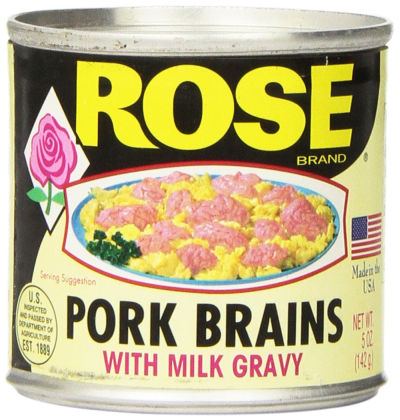
I also remember bodybuilder Jeff Nippard, once sneering at the value of knowing what our ancestors once ate, questioning how on earth this would be relevant to us today. While on BIOS, I’d like to assert that nothing in biology, makes sense but through the lens of evolution. People are very bad with big numbers, the concept of deep time, the vast timescale of geological and cosmic history, often encompassing billions of years is beyond most people’s comprehension and even a few million years is a very long time from a human perspective. A perspective that even when being the oldest and smartest human around only encompasses a span of 100 years. If a food, has been part of our diet, maybe not for eons but at least for epochs or ages (6-65 million years), you are bound to find it reflected in your genes.
One of the oldest surviving Roman cookbooks, "Apicius," includes several recipes featuring brains. One such recipe calls for curing, boiling, and baking lamb brains. It even suggests making them with eggs, pepper, and rose petals. Roman writers like Pliny the Elder mention the consumption of brains as food and even attributed medicinal qualities to them. Even now, in parts of Asia, brains are considered a delicacy. For example, pig brain is featured in some Chinese and Thai dishes. Traditional Chinese medicine has historically utilized animal brains in remedies for various ailments, including headaches and dizziness.
Fried brain sandwiches were more popular in the past, particularly in the American Midwest. Calf and pig brains were often used. The Hilltop Inn is one of the few remaining places in the US where you can still find this dish consistently on the menu. Brain slices are typically dredged in a batter or seasoned flour and pan-fried until crispy on the outside, then served on a bun with toppings like onions, pickles, and mustard.
Up until the 1960s-1980s, it was perfectly normal to feed babies and children organ meats. The practice of introducing these into a baby's diet would typically start with puréed liver or other soft organ meats once the baby begins eating solid foods, around the age of 4 to 6 months. Post-WWII, increasing prosperity and industrialized food production led to a greater focus on cheaper, more readily available muscle meats (like steaks and boneless chicken). As organ meats came to be seen as "old-fashioned" or "poor people's food", there was a decline in their popularity among younger generations. The rise of worries about cholesterol and fat content, often higher in organ meats, further contributed to their decline in Western diets where today, even the provision of “muscle meat” is increasingly shunned by restrictive dietary wokeness.
It's important to note that in many non-Western cultures, organ meats continue to be a valued part of the diet, including for young children and babies being introduced to solid foods. These practices are often rooted in traditional knowledge of nutrition and the importance of these foods for optimal health and development.
Now, let’s take a look at what’s inside the blob space, I can go into some detail, but it is beyond complicated to extrapolate every fatty acid involved. While overlooked, pig brains offer a surprisingly rich source of nutrients. This organ, predominantly composed of water, harbors a wealth of lipids, proteins, minerals, and other valuable compounds. Its unique composition highlights its potential for by-product utilization in the food and health industries. The pig brain is exceptionally lipid-rich, with fat being its most abundant component after water. These lipids consist of neutral lipids, phospholipids, and sphingolipids. Notably, phospholipids in dietary brain (probably the highest among any food) are essential for cell membranes and are readily absorbed by the body.
Infrared spectroscopy analysis of pig brain lipids reveals a diverse lipid composition, including triglycerides, phospholipids, cholesterol, sphingomyelin, and cerebrosides, with specific peaks indicating the presence of various lipid types. The fatty acid profile analysis underscores the brain's richness in long-chain polyunsaturated fatty acids, such as eicosapentaenoic acid and docosahexaenoic acid associated with potential health benefits including cardiovascular disease prevention, antioxidant properties, and memory function improvements.
Phospholipids, essential for cell membrane structure and function, support lipid metabolism and prevent lipid accumulation in the liver. Moreover, the pig brain's cholesterol level, points to a nutritional profile interesting for brain health, albeit with a need for moderated intake due to cholesterol's link to health issues. Cholesterol readily associates with other types of fat though. Although I have no data for this, it is not too far-fetched to think that such dietary brain-derived cholesterol would be able to cross the BBB, counteracting the age-related decline of cholesterol levels in the brain.
Sphingomyelins are a type of sphingolipid found in cell membranes, particularly in the myelin sheath that surrounds and insulates nerve fibers, facilitating the rapid transmission of electrical impulses along nerve cells. Evidence suggests that sphingomyelins and other sphingolipids like cerebrosides may have neuroprotective effects. Pig brains, like the brains of other animals, are considered a good dietary source of sphingomyelins and are essential components of the myelin sheath that insulates nerve fibers.
The lipid class of sphingolipids was discovered after examining brain matter, a typical diet contains an amount of sphingolipids (300-400 mg daily). Research suggests dietary sphingolipids offer health benefits, including the lowering of LDL cholesterol, the suppression of colon cancer, reducing inflammation, and strengthening the skin’s barrier function. Complex sphingolipids (like sphingomyelin) and ceramides cannot be directly absorbed. They must be broken down into sphingosine for the intestines to absorb them. The absorbed sphingosine can then be used to create new sphingolipids but if the diet is high enough most get converted into glycerophospholipids, which can in turn be converted into lysophospholipids. Once you begin to realize there are all these cascade effects, you can begin to appreciate the power of the blobspace.
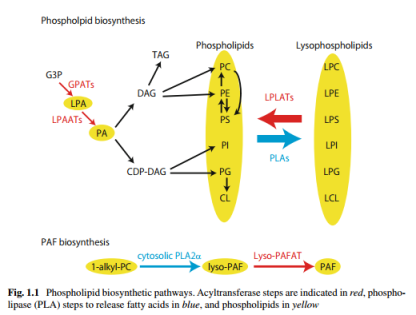
Pig brains deliver neuroprotective glyco- and glycerolipids, such as complex gangliosides and the phospholipids known as plasmalogens (important for cognitive functions and neurological health). The pig brain's plasmalogen content (the highest among any food), particularly ethanolamine plasmalogen, highlights its role in preventing oxidative damage and supporting cognitive functions, suggesting potential for health product development despite challenges posed by high cholesterol levels. Enzymes in the digestive system may break down gangliosides into their parts, such as sialic acid, fatty acids, and glycerol before they are absorbed.
While research is ongoing, this sialic acid could support the body's natural ganglioside production. Sialic acid is a key component of breastmilk, crucial for early brain development. Supplementation in infant formula may improve cognitive function and learning capacity. Studies suggest sialic acid supplementation can enhance memory and other cognitive functions in adults. Sialic acid helps regulate immune responses and might prevent the overactivation of the immune system, reducing excessive inflammation. Some sialic acids on cell surfaces mimic the receptors that viruses and bacteria target. Sialic acid supplements might act as decoys, potentially inhibiting infection. Sialic acid supports the health of the gut lining, promoting a healthy mucosal barrier and aiding in digestion, and may serve as a food source for beneficial gut bacteria, promoting a healthy gut microbiome. Sialic acid might have antioxidant effects, protecting cells from damage. Sialic acid may improve skin hydration and elasticity.
A low intake of n-3 LCPUFAs decreases the DHA level and increases the arachidonic acid (AA) level in the brain (Larrieu et al., 2012). You can assume that the animals from supermarkets or standard butchers in Western countries get little omega-3. But as we’ve seen in “BIOS Needs Brains & Lipids”, DHA levels can be expected to be stable in animals, even when they have bad health. The dietary pig brain has the type of n-3 PUFA PL that is superiorly equipped to traverse the BBB to enrich the brain’s DHA pool.
In 2002, experimental evidence showed that porcine brain phospholipids were 330% more effective than soybean phospholipids (soy lecithin) at raising and maintaining healthy levels of DHA, in rat brain tissues. This research might aid in understanding how to protect the brain during aging. This is due to their ability to form liposome-like structures that can interact with the BBB. Studies have shown that a specific transporter called MFSD2A helps DHA cross the BBB, especially when it's bound to lysophospholipid molecules.
The brain also emerges as a rich mineral source, offering substantial amounts of phosphorus, potassium, sodium, calcium, and magnesium, alongside trace minerals critical for brain development and immune health. Compared to other pig by-products, its notably high levels of iron, zinc, and copper further enhance its dietary value.
In 2021, a retired rancher named Dexter Kruger became the oldest Australian man ever. He celebrated passing the previous record at 111 years and 124 days old. When asked about his secret, Kruger said that eating chicken brains once a week has been part of his diet. His son thinks his simple lifestyle in the Australian Outback has also helped. Kruger said. I would recommend pig brains though because they are more closely linked to long-living species such as humans. I suggest you don’t consume bovine brains for safety reasons. Further down, we’ll also add the consumption of the heart organ into BIOS, because it has a slightly different and complementary lipid profile. At the end of this entire article, I will also disclose how I accidentally discovered how to achieve a sort of “Super Blobspace” by the extra addition of a certain type of food.
SAFETY ISSUES
In the Amazon rainforest, there are accounts of some tribes engaging in the consumption of enemy brains as part of warfare rituals. The Fore people practiced ritualistic consumption of deceased relatives' brains, which led to the spread of kuru disease. In the mid-20th century, a devastating disease called kuru was discovered among the Fore people of Papua New Guinea, linked to the ritual consumption of human brains (particularly of deceased relatives). This led to a critical understanding of prion diseases and their transmission.
Prion diseases, a group of rare and fatal neurodegenerative disorders, are often exclusively linked to cannibalistic practices in people’s minds, due to well-publicized cases like the kuru epidemic among the Fore people. However, this perspective oversimplifies and misrepresents the true nature of prion diseases and their broader implications for human health. The critical issue at the heart of prion diseases is not cannibalism itself but the biological vulnerability of a species to prions—misfolded proteins capable of inducing similar misfolding in normal proteins, leading to progressive brain damage. There’s a species-specific incidence rate, meaning some species are more susceptible than others. Humans and cattle are vulnerable, while birds, pigs, and reptiles are more resistant. Prion disease has never, for example, been naturally found to be present in pigs.
Prions are unique pathogens that defy conventional understanding of infectious agents. Unlike bacteria, viruses, or fungi, prions contain no genetic material. Instead, they propagate their harmful effects through a novel mechanism: a misfolded prion protein can induce other normal prion proteins to adopt its abnormal shape, causing a chain reaction that ultimately results in extensive neural damage. This process can occur in various species, leading to diseases such as Creutzfeldt-Jakob Disease (CJD) in humans, Bovine Spongiform Encephalopathy (BSE, or "mad cow disease") in cattle, and Chronic Wasting Disease (CWD) in deer and elk, vulnerable species can also cross-contaminate each other.
The connection between prion diseases and cannibalism, particularly in the case of kuru, stems from the specific practice of consuming the nervous tissue of deceased individuals, which contains high concentrations of prion proteins. However, the broader concern is the susceptibility of organisms to prion infection through any exposure to contaminated tissue—whether through dietary, medical, or accidental means. For example, variant Creutzfeldt-Jakob Disease (vCJD) emerged not from cannibalism but from consuming beef products contaminated with BSE.
The outbreak of Bovine Spongiform Encephalopathy (BSE), or "mad cow disease," in the 1980s created concern over the safety of consuming bovine products, especially brain tissue. This led to widespread bans on feeding cattle meat-and-bone meals (the main culprit in BSE transmission) and the implementation of rigorous testing programs. Many countries, particularly within the European Union, imposed strict restrictions on bovine brain consumption, particularly from older animals, due to the concentration of infectious prions in brain tissue. While stricter regulations have significantly reduced the incidence of BSE, the risk hasn't entirely disappeared, leading to the continued monitoring and regulation of bovine product consumption in various regions. It is still forbidden to sell bovine brains for consumption in Europe while pig brains remain available.
Some key points to remember; prion disease is not so much about cannibalism per se but about a species’ vulnerability to prion-related disease. Nervous tissue, especially things like brains are the place where prions would be present. It is considered to be safe to consume brains from pigs, as pigs don’t naturally develop these diseases.
SAFETY ISSUE
The pig brain, like any other brain, is very rich in cholesterol. 100 grams would contain 2000 mg of cholesterol when the guidelines say limit to 300 mg of cholesterol a day. This looks like excessively much, but your body's cholesterol absorption system has a limited capacity. As you consume more pig brains during the meal, the percentage of cholesterol absorbed will gradually decrease and the body will downregulate its own production. This is just speculation on my part, but it is also observed in the literature, that there does seem to be a level of intake of dietary cholesterol where consuming even more has little or no effect. Brains also contain certain lipids that either bind to the cholesterol potentially increasing BBB transport potential or lowering the uptake in the gut, where we don’t want to have cholesterol circulating, sphingomyelin does this.
There are a couple of foods like squid, which have even higher cholesterol levels, but they are few. What I want to note about this, is the fact that most fish are rich sources of cholesterol (50-100 mg per 100 gram), and yet, these are found to be life extenders in most of the research despite their cholesterol level. You could compare brains to egg yolks to get a general idea about the levels involved. Dietary brains are also consumed in Blue Zones such as in Greece, so moderate intake should go a long way. One thing it tells us, is don’t go overboard, stick to one - two brain eating sessions a month, and adjust according to your LDL values. We’re not zombies, now are we?
The metabolism of cholesterol undergoes significant changes with aging, and these changes differ between sexes. For men, plasma cholesterol levels increase steadily up until around the age of 50, after which they begin to decline. Women, on the other hand, experience an elevation in cholesterol levels post-menopause compared to their younger selves. This elevation is linked to a decrease in estrogen levels, which play a crucial role in regulating lipid metabolism in the liver. As a result, there's an increase in LDL (low-density lipoprotein) cholesterol levels.
Cholesterol metabolism within the brain is also affected by aging. There's a reported decline in cholesterol synthesis in the hippocampus, an area of the brain crucial for memory and learning. While some studies suggest that a reduction in cholesterol turnover could be beneficial by stabilizing cholesterol levels during aging, others argue that it could lead to cognitive decline. This is because impaired cholesterol synthesis is associated with reduced synaptic plasticity, affecting the brain's ability to form new connections and learn. (Cadyrov, 2022).
✅ Consume Blobspace once or twice a month
Phospholipids
It would be overly complicated for me to cover each and every possible bioactive lipid individually. For most of them, there is also little research available. That should be one of the reasons why the availability of a dietary “Blobspace” is so convenient. It probably covers all our needs, without having to know the details. There is one group of bioactive lipids deserving a closer look though, phospholipids. It is important to get these from our diet in general (glycerophospholipids), but also phospholipid types known as plasmalogens and lysophospholipids, deserve attention on their own. Let’s discuss these now.
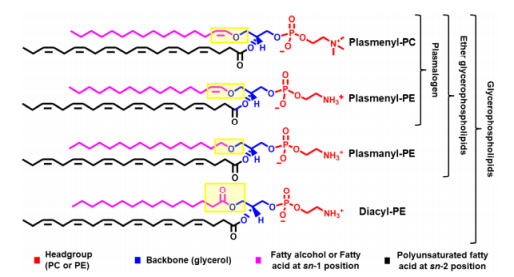
1 - Glycerophospholipids (GLPCs)
Most tissues, including the brain, can produce phospholipids (GLPCs) in the endoplasmic reticulum using phosphatidic acid and diacylglycerol as precursors. We also get GLPCs from our diet, and they have good bioavailability. Certain beneficial gut bacteria produce phospholipids, especially Sphingolipids.
“It is impressive how GPLs, even though being "only" a food component, can interact with the cellular membranes, changing their compositions (and probably their lipid microstructure and the lipid rafts) and thereby influencing a vast quantity of signaling processes and enzymatic activities. Since there have been many studies with remarkable effects performed during the past two decades, one could assume that GPLs are a "miracle drug". One explanation for the mentioned outstanding effects might be that our eating behavior has changed during the last 1-2 centuries towards a suboptimal GPL-uptake, namely not enough GPLs”. (Küllenberg, D., Taylor, L.A., Schneider, M. et al. Health effects of dietary phospholipids. Lipids Health Dis 11, 3 (2012).
The beneficial effects of dietary phospholipids on cognitive functions have been recognized since the early 1900s (Schverer, 2020), with studies indicating their positive impact on cognitive processes in both health and disease. Research in piglets, rats, and mice suggests that diets enriched with phospholipids might improve various aspects of cognition during development, including spatial memory, recognition memory, and working memory. Human studies with formulas enriched in phospholipids (like gangliosides or MFGM) suggest potential benefits for cognition and behavior in infants and children. Interestingly, the benefits may be comparable to breastfed infants, highlighting the role of phospholipids in breast milk.
Lifelong supplementation in piglets has shown enhanced memory performance and increased brain mass, underlining the cognitive advantages of phospholipids. Dietary phospholipids can affect brain phospholipid levels and cognitive behavior. Supplementation in animal models has been linked to improved learning and restoration of phospholipid deficits. Maternal diets enriched in phospholipids can alter neonatal brain lipid composition, suggesting early dietary interventions could have lasting cognitive benefits. Studies indicate that phospholipid-rich diets could improve spatial memory in aged rats, possibly due to enhancing cholinergic neurotransmission (a system crucial for memory).
For example, phosphatidylcholine (PC) supplementation has been found to slow aging-related processes and improve cognitive function in dementia. PC from eggs, for instance, has been shown to enhance memory and cognition in mice, alongside reducing beta-amyloid production. Initial research with phosphatidylserine (PS) suggested improvements in cognition and brain activity measures in elderly individuals with cognitive impairments and early-stage Alzheimer's disease.
Both animal models and human studies have shown that diets enriched with DHA-PC or DHA-PS can elevate the levels of antioxidative enzymes such as superoxide dismutase (SOD) and glutathione peroxidase (GSH-Px). These enzymes play crucial roles in reducing oxidative stress within the brain by neutralizing free radicals and reducing lipid peroxidation, thus protecting neuronal integrity. (Lo Van, 2022). A prospective follow-up study in humans revealed that higher baseline plasma levels of DHA-PC were associated with significantly reduced risks of developing Alzheimer's disease and all-cause dementia. This points to the potential of DHA-PC as a biomarker for AD risk assessment and highlights the protective effect of DHA against neurodegenerative diseases.
Phospholipids, as crucial components of cell mitochondrial membranes, could directly support healthy cell structure and function of the electron transport chain. Through aging, mitochondrial membranes get damaged by free radicals and ideally are repaired or replaced. Membrane lipid replacement therapy involves phospholipid supplementation and aims to repair or replace damaged mitochondrial cell membranes caused by aging and free radicals. This therapy is explored for its potential benefits in conditions like chronic fatigue syndrome, heart disease, inflammation, and cancer, by maintaining the health of membranes of mitochondria.
Membrane lipid composition can directly impact the efficiency of mitochondrial energy production, a process that declines with age. Oxidative stress due to mitochondrial dysfunction is a suspected contributor to various neurodegenerative diseases and age-related eye diseases like glaucoma. The formation and function of autophagic vesicles depend heavily on lipid availability, specific lipid-sensing proteins, and the lipid modification of key autophagy-related proteins.
Cardiolipin is a unique phospholipid found in mitochondria. It plays a functional role in mitochondrial membranes, influencing energy production and overall cellular health. Given its importance, maintaining or raising cardiolipin levels can be crucial, especially in the context of certain diseases or aging, where cardiolipin levels may decline. To maintain proper levels think about PS, PUFAs, CoQ10, Carnitine, and Pyrroloquinoline Quinone (PQQ). (All parts of BIOS supplementation, except for PQQ which I need to research further).
✅ Acetyl-L-carnitine, no more than 800mg a day. May also increase attention span, and may also reduce leptin resistance. Antioxidant.
A 2006 study by Kingsley on soccer players shows increased exercise performance after supplementing with PLs. Phospholipid supplementation during aging, of all forms PC, PE, PS, including the Esther forms have all shown protection for the aging brain and for cognitive function. (Wei Xiong, 2023).
Link to Growth Factors. Studies indicate that the phospholipid content in certain brain regions decreases with age, but whether this is a key driver of cognitive decline is still being investigated. Rather than simply replacing declining phospholipid levels, these supplements might act by supporting the mechanisms of neuroplasticity.
Link with the Hypothalamic-Pituitary-Adrenal Axis (HPA Axis). Phospholipid supplementation potentially modulates the HPA axis, which controls the stress response. High levels of stress hormones can negatively impact cognition. Evidence suggests phospholipid-rich diets could buffer stress-related cortisol elevations and improve cognition in individuals facing stressors.
The milk fat globule membrane (MFGM), found in milk from cows and humans, is particularly rich in phospholipids, which comprise 60%-70% of its bioactive components. These phospholipids are crucial for brain development and function. Egg yolk is also a source of phospholipids, including phosphatidylcholine and phosphatidylethanolamine. Similarly, soybeans offer a plant-based source of phospholipids, mainly consisting of phosphatidylcholine, phosphatidylethanolamine, and phosphatidylinositol, highlighting the variety of dietary sources for these essential nutrients.
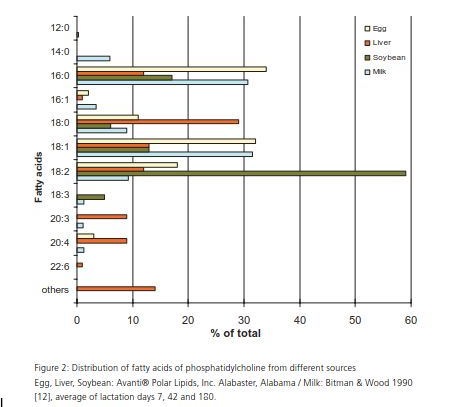
Eggs are the most important (mainstream) dietary source of phospholipids. The EFSA allows a health claim for products containing PLs based on increasing cerebral metabolic processes, helping mental and cognitive activity. Krill oil and liver contain ample PLs too.
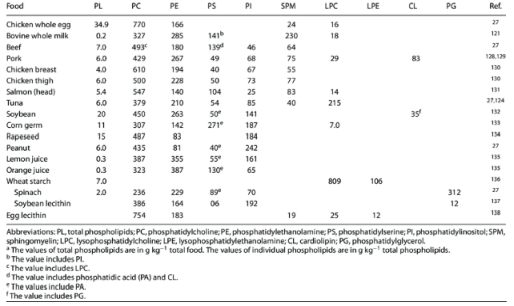
There is widespread commercial use of phospholipids (PLs) in industries such as pharmaceuticals, cosmetics, and food manufacturing. Phospholipids, commonly referred to as lecithin in these applications, are predominantly sourced from vegetables. They are versatile in industrial applications because of their emulsifying properties.
Bryan Johnson takes soy lecithin in his blueprint, this is because he needs to make up for the lack of choline in his vegan diet. But soy lecithin does indeed also supply phospholipids, something his diet, again, is otherwise not delivering from animal foods. Lysophospholipids from soy are however poorly taken up by the brain, certainly when compared to pig brain consumption.
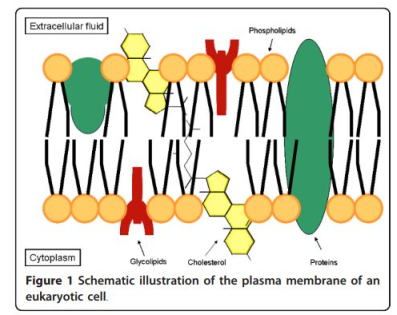
Phosphatidylserine improves cognitive function in the young & lowers stress. Reduces amyloid beta in the brain which protects against Alzheimer’s. Lowers cortisol from exercise and raises testosterone, other glycerophospholipids like phosphatidylcholine have also been found to counteract age-related brain shrinkage.
While phospholipids are healthy for the brain, they are an order of magnitude healthier when they are bound to omega-3 molecules. The n-3 LCPUFA content in the brain is highly affected by aging in the absence of an n-3 LCPUFA-enriched diet (Joffre et al., 2016).
ω-3 in the triglyceride form (n-3 PUFA TAG) (as in fish oils) has poor bioavailability, limited antithrombotic activity, and generally does not pass the blood-brain barrier, so it is useless for brain health. And useless for ocular health too, the retina's high DHA and VLC-PUFA content is crucial for the function of photoreceptor cells and visual processing and has its own version of a BBB. Research shows a decrease in DHA, and VLC-PUFAs in the retinas of individuals with AMD compared to healthy controls.
ω-3 in phospholipid form (n-3 PUFA PL) has increased bioavailability across the entire body and can cross the BBB and enrich the brain/eyes. An example of these forms can be found in krill oil, which has some n-3 PUFA PL next to its n-3 PUFA TAG, certainly when purified. Phospholipid plasmalogens (discussed at length further down) excel in delivering omega-3s, particularly to the brain, potentially surpassing both regular phospholipids and triglycerides. This is the main way how consuming pig brains would be a very potent brain DHA enrichment strategy. Additionally, lysoglycerophospholipid-bound DHA, which we will discuss next, can be regarded as another superior bioavailable form of delivering n-3 to the brain.
Epidemiological studies suggest a link between high DHA intake and reduced risk of some cancers. The way in which DHA is delivered to cells (within these different lipid structures) might affect its biological activity. The specific lipid carrier greatly influences how effectively DHA reduces breast cancer cell viability.
✅ The brain has a remarkably high concentration of phospholipids (PLs) compared to other organs. Among these, PE-DHAs are the most abundant, serving as the primary DHA storage form. PC and PS also play roles in DHA transport to the brain.
✅ Consume eggs, soybeans, beef, liver, milk, and chicken breasts and marine sources as a good source for PLs.
✅ See the plasmalogen chapter on my suggested phospholipid supplements.
2 - Lysophospholipids (lysoPL)
In the digestive system, more than 90% of phospholipids are absorbed, primarily after being broken down into free fatty acids (FFAs) and lysophospholipids (lysoPL) within the intestinal lumen. For example, when an enzyme called phospholipase A2 (PLA2) acts on phosphatidylcholine (PC), it creates Lysophosphatidylcholine (LPC), a type of lyso-PL. These smaller lipids, missing a fatty acid, play important roles in cell signaling and membrane structure.
Lyso-PLs, having lost one fatty acid chain compared to regular PLs, are smaller and have a better chance of directly crossing the blood-brain-barrier (BBB) and the blood-ocular-barrier (BOB), which prefer smaller, less charged molecules. Research suggests specific transporter proteins at the BBB and BOB, like Mfsd2a, are designed to recognize and transport Lyso-PC-DHA. This provides a dedicated entry pathway. Some receptors don't have known substances that bind to them (ligands). Scientists have also discovered that some orphan receptors at these sites do respond to lysophospholipids, again constituting a dedicated entry mechanism.
But what is the big-picture biological reason for this? During brain development, the brain actively creates Lyso-PLs from enzymes that it uses on fatty acids to incorporate DHA into its membranes. So any Lyso-PL-DHA circulating in the body seems to tap into these existing mechanisms for efficient uptake. They are also components of human breast milk.
So even though scientists are discovering this “technique”, it is just basic biology. (Allthough scientists can indeed tinker with certain variables, like adding it to EPA or by 1-Acetyl,2-docosahexaenoyl-glycerophosphocholine (AceDoPC), a synthetic structural variant of lysophosphatidylcholine (LysoPC) that has been engineered to optimize the delivery of docosahexaenoic acid (DHA) to the brain.)

In the past, several animal studies showed that DHA from supplements (fish oil, krill oil, algal oil, ethyl esters) was not incorporated appreciably into the adult brain, although other tissues were enriched. (Sugasini, 2019).
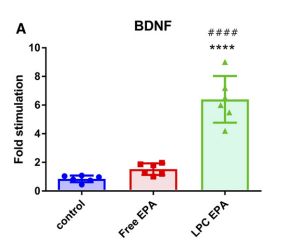
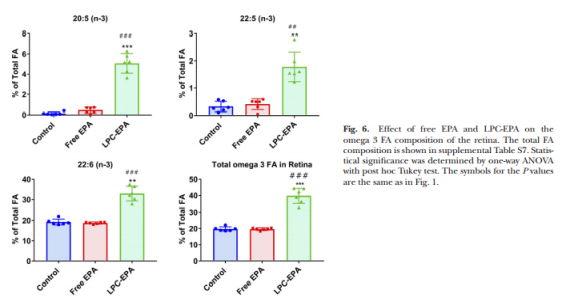
So unless omega-3 like DHA or EPA is bound to phospholipids, and preferably to lysophospholipid, it can’t get in the brain or the eyes by any appreciable amount. So, where do you get the lysophospholipids from?
Some limited dietary sources provide preformed Lyso-PL-DHA and can be directly absorbed, like fish and krill oil, egg yolks, pig brains, and fish roe, but usually in small amounts. More commonly, we consume phospholipids and triglycerides that our bodies break down, a percentage of this results in creating Lyso-PLs while the bulk turns into other phospholipids and DHL. When Lyso-PLs are formed in this manner, our body might attach DHA to them if it is available, resulting in endogenous Lyso-PL-DHA.
Lysophosphoslipid-DHA is now recognized as a novel nutraceutical approach for the prevention and treatment of retinopathy and neurodegenerative diseases. Scientists have been developing products that can deliver Lyso-PL-DHA directly. But these did not yet exist. Currently, a lipase-treated krill oil creates an LPC-enriched version that increases bioavailability to the brain. Treating PC-PUFA (PC-DHA + PC-EPA) with a lipase that cleaves at the sn-1 position can generate LPC-DHA and LPC-EPA. I believe the first supplemental form of lysophospholipid rich Omega-3 for the market is being developed by AKER BIOMARINE and is called LYSOVETA.
Conclusions
✅ The brain and eyes rely heavily on phospholipids, especially those carrying DHA, for optimal function. While these PL-DHAs have higher bioavailability as compared to TAG-DHA, Lysophospholipid-DHA is the preferred biological carrier.
✨ DHA in the brain has signaling functions that raise BDNF levels. Supplementing with preformed DHA that is bound to phospholipids/lysophospholipids can cross the BBB and will directly raise brain BDNF levels, it does this so reliably that BDNF can be used as a biomarker to gauge DHA levels in the brain as an alternative for the Omega-3 index used for serum values. Lyso-PC-DHA is the Lyso-PL form mostly abundant in the brain more than other organs such as the liver, retina, heart, and kidney. This presumably makes blob space a good dietary source. The brain contains the highest content of PLs in comparison to other organs. Among these PLs, PE-DHAs are the most abundant, thus constituting the major storage of DHA although PC and PS are also known to transport DHA to the brain.
✅ It would be very convenient to be able to supplement this form, unfortunately, the research is still cutting edge and there are few options out there, there’s a porcine liver decomposition product (PLDP) but cannot be found easily outside the research context. Blob space should be able to deliver. Krill oil could contain a small amount but fails to increase DHA brain levels in studies. I’ve seen Rhonda Patrick suggest salmon roe and Kris Verburgh suggest fish roe in general. While fish roe products are often hinted at to contain phospholipids, these are often loaded with added salt. Also, not all contain them, marine fish roe might, and freshwater roe might not. Think salmon, herring, cod, sardine, mackerel roe. Unless you are consciously doing salt loading for sports performance, this might not be the best option. A roe oil supplement could cut out the salt burden, for example, Romega herring roe oil, but this contains phospholipids and only a very limited amount of the lysophospholipid kind. (Cook, 2018), in my opinion, it would fail to get DHA in the brain in the same was as krill oil fails. Aker Biomarine has the Superba Krill oil product with purified phospholipids, while doing little to deliver the lyso-form, it does have more choline and PLs. This same company is now manufacturing the first lysophospholipid product for the (human) market.
✅ Supplement with Lysoveta (Aker Biomarine) when it becomes available on the market. Lipidol is another option, but this one might be difficult to source because it is mostly used to promote animal health. (The irony).
3 - Plasmalogens
Where do we find plasmalogens in the diet? Levels of plasmalogen consumed in a normal diet appear to survive short exposure to stomach acid but have a low absorption factor. Although dietary plasmalogens have a low absorption factor, marked increases in plasma and liver plasmalogens were observed in rats fed a plasmalogen supplement extracted from bovine brain.
Moreover, purified plasmalogens (mostly PE plasmalogens) from chicken skin were found to be effective in increasing erythrocyte, plasmalogens in rats, and purified plasmalogens from ascidian viscera were also shown to increase endogenous plasmalogens in rat plasma, erythrocytes, and liver. Dietary plasmalogens Marine foodstuffs, particularly blue mussel, and ascidian contain high levels of PE plasmalogens (as a proportion of the glycerophosphoethanolamine fraction).
Orally administered scallop extract alleviates negative mood states and sleep problems and also enhances mental concentration. (Fujino, 2022). Krill oil has been reported to contain free fatty acids including n-3 and n-6 PUFA primarily incorporated into phospholipids, more specifically into PCs, lysoPCs, and alkylPCs. The effects of krill oil supplementation on circulatory and tissue plasmalogen levels have not been clearly defined.
Sea squirt-derived pPE has been shown to reduce inflammation in human colon cells, important for combating colon cancer. Previous studies suggest diets high in pPE may protect against colon cancer, likely by reducing inflammation and oxidative stress. This indicates that supplementing with plasmalogens could provide anti-inflammatory effects in the digestive tract and, if absorbed, in the brain and other tissues.
Alkylglycerols in shark liver oil supplements are predominantly present as 1-O-alkyl-2,3-diacylglycerols. These supplements are designed to feed into the plasmalogen biosynthetic pathway, potentially offering health benefits attributed to their high alkylglycerol content. The purification procedures for commercial shark liver oil supplements aim to reduce levels of unwanted substances like squalene, toxic heavy metals, free fatty acids, fat-soluble vitamins, and pesticides, making the supplements safer for consumption.
Products like Alkyrol® and Ecomer® are examples of commercial shark liver oil supplements that have been marketed for their immune-stimulating and anti-tumor activities, with O-18:1 alkylglycerol being identified as a particularly active component. It's worth noting, however, that while there are numerous studies on the therapeutic properties of shark liver oil and its components, the specific effects of alkylglycerols on plasmalogen modulation in disease settings require further research for full characterization.
The main plasmalogens found in regular foods are ethanolamine plasmalogen (EPLAS) and choline plasmalogen (CPLAS). Mussels and Ascidian (sea squirt) are rich sources of plasmalogen, especially EPLAS. Mussel powder is already produced and processed in NZ. The residual powder from that processing contains the phospholipids and therefore the plasmalogens. Most meat has some EPLAS too and CPLAS, which seems to be lacking in marine foods.

Plasmalogen content is significantly higher in human milk (>30% of total PE) than in cow milk (<8% of total PE). But overall, not a great source. Eggs are rich in EPLAS and would follow mussels. Most organ meats compare to regular meat, except for heart, which is very rich in CPLAS and EPLAS. The brain is extremely rich in EPLAS and has a total plasmalogen content close to 600% more as compared to mussels on a gram-to-gram basis.
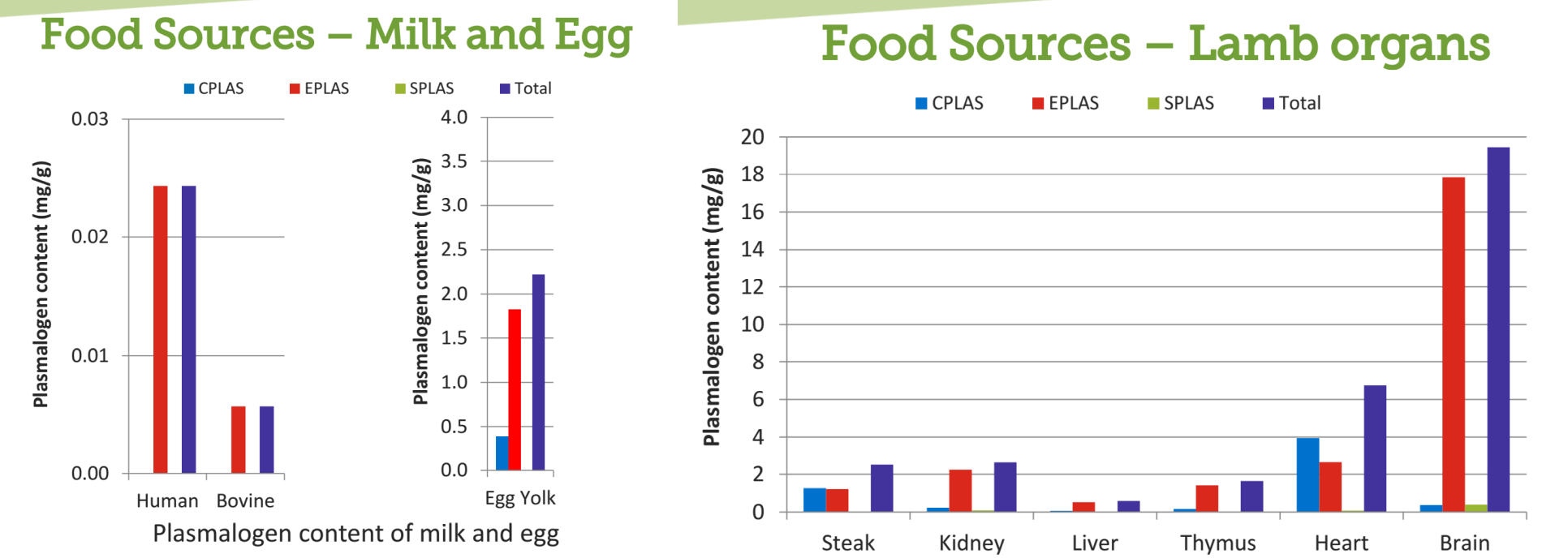
In the human brain, plasmalogen levels peak in middle age and tend to decrease in old age along with myelin which is rich in EPLAS. It would be very convenient for brain health to start including dietary pig brain to the diet around age 40. Blood levels of people with Alzheimer's show marked decreases in EPLAS levels and these low levels weaken the blood and brain. I think it would make sense to get a top food for each Pls type.
For BIOS-DIET we have a selection based on this.
✅Pig brain, mussels, and eggs for EPLAS.
✅Heart, beef, lamb, and hare for CPLAS.
✅Mussels for SPLAS.
The literature is dubious on how to implement plasmalogen replacement therapy. Some papers say dietary plasmalogens are higher and better bioavailable, while other papers suggest that levels in extracts and supplements are better for the same reason. For BIOS, I would like to suggest making sure to include the foods we selected and additionally take one or so supplements based on some type of high PLS animal-based food.
✅ Ascidian PLS✅ Blue mussel PLS✅ Scallop PLS✅ Shark Liver Oil (Alkylglycerols), f.e. Alkyrol® and Ecomer®✅ Sea Squirt PLS✅ Chicken PLS (these won’t have n-3’s like brain or marine PLS and might thus be less effective)
Inositol
Myo-inositol (inositol), one of the oldest components of living beings, is a cyclic carbohydrate synthesized by the brain (the brain reaches levels 10 to 15--fold the serum values) and kidneys in animals, or the bran and seeds in plants. Even though inositol is essential in animals, there is no established recommendation for human dietary intake. (Bizzarri, 2016). It was once thought to be a B vitamin.
Besides functions as a free-form molecule, it’s also a component of structural lipids and secondary messengers. Myo-inositol is one of 9 inositol stereoisomers and it helps to form other inositol compounds including inositol glycans, phospholipids, phosphates, ethers, esters. Supplementation increases plasmalogen levels and reduces atherogenic cholesterol, suggesting potential benefits for metabolic syndrome.
Caffeine intake lowers our levels, as does the aging process. Some scientists have suggested that we might need supplementation because inositol-rich foods like brains, kidneys, and blood are no longer consumed. (doi:10.1136/ openhrt-2022-001989). Also, plants use inositol to store phosphorus, and in the modern food chain, phytic acid is mostly removed from foods as an “anti-nutrient”, which lowers our inositol intake further.
The body can convert Myo-inositol into D-chiro-inositol (DCI) and vice-versa, maintaining a balance between the two forms. I remember from some of my literature reviews that the D form has been found to raise free testosterone levels. Inositol can also be taken as a sleep stack supplement, through its function to raise serotonin levels. Commensal bacteria have been found to be able to convert dietary inositol to SCFAs like acetate and propionate, which in turn have been found to be important factors in aiding brain health through neuroprotection against Parkinson’s.
Human breast milk has Myo-inositol in high levels during early lactation when neuronal connections form rapidly in the infant's brain. Myo-inositol promotes synapse abundance in neurons in a dose-dependent manner. Inositol has been found to be bioactive, even to mature brain tissue, meaning it promotes the formation of neuronal connections. (Paquette, 2023).
✅ Having blobspace on BIOS once or twice a month, comes a long way in replenishing our levels of inositol, BIOS also has wheat germ which delivers phytic acid. A Western diet provides around 1 gram of inositol on average. If you still feel like raising your levels, you could take 1 gram of supplemental inositol once or twice daily. preferably co-administrate with a plasmalogen extract (2)
Cognitive Reserve Capacity
We’ve seen that humans have an above-baseline capacity of neuronal power. What works for humankind, also works for individuals. This spare capacity can come from flexing our “brain muscles”. For example, taxi drivers develop larger hippocampi, a brain region crucial for memory and navigation. Musicians show structural changes in brain areas involved in music processing, motor control, and hearing. Bilingual individuals often have advantages in language and memory regions of the brain. People with stronger cognitive reserves have more brain volume, greater numbers of neurons, and enhanced connections. When these individuals experience decline, their brains have extra resources to draw upon. It's like having backup systems in place. They are of course, also better protected against getting the disease in the first place. Extra brain, is good for us.
As with muscles, the brain works on a "use it or lose it" principle. Cab drivers that retire, would eventually lose the bigger size of their hippocampus. So it’s important to start on a quest of lifelong learning, for example, through academic learning, or doing intellectually stimulating activities like learning a new language. If these activities are memory intensive and especially involve spatial navigation and exploration, studies show they appear to be extra powerful brain builders. Playing various sports might be a good candidate, sports that emphasize spatial awareness, complex movement patterns, strategic thinking, and adaptability tend to be most beneficial, basketball, orienteering, soccer, and dancing. Actively learning, practicing new skills, and strategizing within a sport provides a greater cognitive challenge than simply playing casually.
Brain-derived neurotrophic factor (BDNF)
One way that the discussed mental and physical activities built the cognitive reserve capacity is by raising the levels of BDNF in the brain. Brain-derived neurotrophic factor (BDNF) is a powerful growth factor for your brain, promoting its development, health, and resilience. But this special protein goes beyond the brain: it's involved in muscle regeneration, metabolism, and energy production. In the latest research, scientists are discovering that it is a metabolic hormone.
BDNF plays a role in the brain throughout our lives. It guides the development of the nervous system before birth and supports its health and functions well into adulthood. Without enough BDNF, neurons struggle, increasing the risk of diseases like Alzheimer's, Parkinson's, depression, and more. Even though our natural BDNF levels decrease with age, certain activities like exercise, learning, and diet can boost them, protecting memory, learning ability, and mood.
Muscles also produce BDNF, and this has benefits for both the brain and the body. When released during exercise, BDNF travels to the brain for those cognitive benefits while simultaneously helping muscles recover from injury and adapt to become stronger. BDNF even influences how muscles use energy and may play a role in blood sugar control.
Intense exercise increases lactate production, a molecule formerly considered metabolic waste. It turns out that lactate is a powerful signaling molecule with surprising benefits for the brain. It promotes the growth of new blood vessels in the brain, delivers a valuable energy source, and generally boosts brain health. Exercise also directly increases BDNF production, which triggers processes that create more energy within brain cells, protect them from damage, and promote healthy brain aging.
While delivering BDNF directly as a medicine is difficult, diet, exercise, and even some potential dietary "hacks" can significantly influence your natural BDNF levels. This means you can support both your brain and your body through simple lifestyle changes.
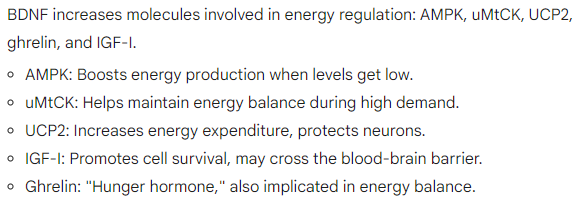
BDNF, the brain growth factor, also plays a crucial role in managing hunger, energy use, and even body temperature. It acts within the brain's hypothalamus and hindbrain – areas involved in regulating food intake – to help the body sense fullness (satiety) and reduce the desire to eat. Studies with mice show that low BDNF levels lead to obesity while increasing BDNF causes reduced food intake, weight loss, and improved blood sugar management. BDNF also promotes the conversion of less beneficial white fat into calorie-burning brown fat (BAT cells), which increases energy expenditure and body temperature.
Beyond its impact on appetite and energy balance, BDNF has emerging importance for the heart and blood vessels. It plays a role in the healthy development of the heart and blood vessels, influences heart rate through the nervous system, and promotes the survival of heart muscle cells. Increased BDNF also stimulates the production of factors that support blood vessel growth, potentially reducing cardiovascular risk. However, researchers are still investigating the specific ways BDNF protects cardiovascular health and how these effects are influenced by our genes.
BDNF QUICK HACKS
🧙All modalities of movement raise BDNF levels, causing a quick but temporary spike in BDNF. However, regular exercise promotes sustained cognitive improvement and neurogenesis (the growth of new neurons). Exercise sessions of at least 30 minutes are recommended, though longer sessions (around 40 minutes) may lead to higher BDNF increases, and intense exercise could be even more powerful to generate BDNF because in this modality lactate is generated which crosses the BBB and raises BDNF.
✅During vigorous physical activity, the body produces lactic acid due to anaerobic metabolism in the muscles. Quickly, this lactic acid dissociates into lactate and hydrogen ions. The lactate can then circulate through the bloodstream and reach the brain. Lactate binds to specific receptors (like HCAR1) in the brain, initiating signaling pathways that promote gene expression and angiogenesis (new blood vessel formation), contributing to brain health while also raising BDNF levels.
Molkosan is a prebiotic health product made from concentrated whey that is fermented to enrich it with lactic acid, particularly the L(+) form, which is considered beneficial for gut health. The systemic and neurological impacts of lactate produced internally through exercise may not be directly comparable to those of lactic acid entering the body through diet, so this might be speculation. But even if it doesn’t work to raise BDNF through lactate; this specific form of lactic acid supports the growth of beneficial gut bacteria (who like the acid milieu) and can contribute to a healthy digestive system for probiotics, and this has also been shown to raise BDNF.
Exercise affects how lactate is transported between cells (astrocytes and neurons) and influences the activity of the specific receptor HCAR1, enhancing the positive effects of lactate on brain plasticity. It might be most beneficial to take this as a pre-workout supplement.
✨Probiotics may be effective in elevating BDNF levels in patients with depression and neurological disorders. Remember, only natural probiotic foods are allowed on BIOS and no supplements of individual bacterial strains. BDNF regulates gut barrier integrity.
🧙Rosemary (as in tea) increases BDNF levels in the brain, Some studies show that rosemary can aid brain function, especially when grown in Acciaroli, Italy.
✨Polyphenols, especially flavanols, a type of polyphenol widely found in fruits, vegetables, tea, wine, and cocoa can cross the BBB and raise BDNF.
🧙Mental “exercise” also raises BDNF levels, it’s not only physical.
✅HEAT FOR BDNF
Heat stress upregulates BDNF production, thereby supporting neurogenesis. (also see BIOS Needs Heat). Scientists also noticed that people who exercised in a warm environment had higher blood levels of BDNF than cool-room exercisers.
A study by Japanese researchers examined the effects of heat exposure on brain-derived neurotrophic factor (BDNF) levels. Results showed that immersion in hot water, raising core body temperature to approximately 39.5°C, significantly increased BDNF levels, unlike the lukewarm condition. Furthermore, cortisol levels decreased after hot water immersion. This suggests that the benefits of heat exposure for the brain can potentially be achieved through taking a hot bath, without needing a sauna.
Heat releases endorphins. Opioids are a family of psychoactive substances that have potent analgesic (pain-relieving) effects. The brain produces its endogenous opioids in the form of endorphins. As with the other opioids, endorphins suppress pain-signalling and produce feelings of euphoria. Endorphins are released in response to heat exposure. Heat reduces inflammation C-reactive protein (CRP) is one of the most studied and robust markers of chronic systemic inflammation.
Heat exposure also stimulates the production of heat shock proteins (HSPs), which assist in refolding or degrading misfolded proteins, such as amyloid-beta, thus preventing their accumulation and supporting brain health. Research also highlights the potential of heat treatment in managing depression, with studies showing improvements in symptoms from both single sessions and repeated exposure to heat. Moreover, consistent sauna use has been associated with a lower risk of dementia and Alzheimer’s disease, suggesting a dose-response relationship where even 20 minutes at 80°C can be beneficial. For those new to sauna use, it's recommended to start with short sessions and gradually increase the duration to build heat tolerance, aiming for once or twice a week to maximize health benefits.
NEUROGENESIS
For a long time, scientists believed the brain couldn't grow new neurons in adulthood – that we were stuck with the number we were born with. But the discovery of adult neurogenesis changed everything! It turns out, that our brains have the capacity to create fresh neurons throughout our lives, a process essential for learning, adapting, and even recovery from injuries.
BDNF directly encourages the production of new neurons and helps them thrive by promoting their growth and connections within the brain. BDNF's influence is especially strong in the hippocampus, which is needed for learning and memory. This is why activities that boost BDNF often improve cognitive function as well.
The importance of ongoing neurogenesis becomes clear when we think about brain health. It provides a way for the brain to repair itself and build new pathways, potentially helping after injury or disease. BDNF may also help counteract the decline in neurogenesis that comes with aging, protecting our memory and thinking abilities. Researchers are even exploring how to harness BDNF's power to develop new treatments for conditions like Alzheimer's, a disease where neurons are damaged.
BDNF → NEUROGENESIS → COGNITIVE RESERVE CAPACITY (AKA “MORE BRAINS”)
Nutrients For The Brain
The animal brain evolved 600 million years ago in the ocean and was dependent on DHA and compounds essential to the brain such as iodine, which is also in short supply on land. To build a brain, you would need building blocks that were rich at sea and on rocky shores. Neurologically important nutrients such are EPA, DHA, ARA, B12, iodine, and choline. Most will become depleted on a vegetarian diet. Choline and DHA are problematic for the general population, for example, surveys show that 90% of Americans (and other Westerners) are getting insufficient choline (essential for building phospholipids) and that they are consuming only 1/5th of the daily amount of ω3s recommended.
BIOS ω−6
On a diet of processed foods, you would have a big exposure to seed oils rich in omega-6. On a whole food diet, you would probably struggle to reach the RDI (linoleic acid, 12-17 g/d). If you throw out processed foods, this would open up a space where you are now free to select high-quality forms of omega-6 sources that can help you reach the RDI while having bioactive properties that stand to benefit health superiorly as compared to passive processed food consumption.
✅ USE SUNFLOWER SEEDS DAILY
A handful (2TBSP) of sunflower seeds or walnuts would deliver 10 grams of omega-6 fatty acid linoleic acid.
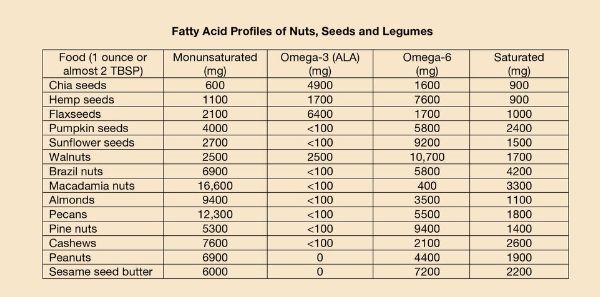
🍽️ CONSUME ARACHIDONIC-RICH FOODS
ARA is found only in animal-derived foods because plants cannot synthesize C-20 LCPUFAs and conversion is very low. So make sure to consume arachidonic acid-rich foods regularly as part of your normal diet; including meat, poultry, eggs, fish, and dairy. Even in these foods, the ARA content is relatively low. Stop short of supplements though, which are being taken by body-builders to enhance muscle production. In the worst-case scenario, take one low dose of ARA as an isolated supplement per week. Most people get the bulk of ARA from meat and poultry. Overall, chicken appears to be the highest source (Kawashima, 2019), especially with skin. And fish like sardines are equally as good.
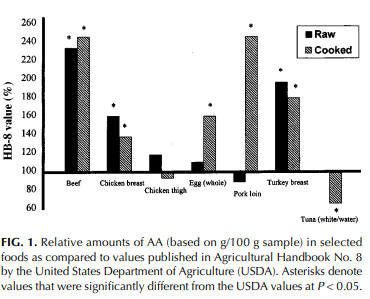
Most if not all forms of omega-6s reduce overall mortality, just as omega-3s do. Thus it has been suggested that the use of ω3/ω6 ratios to assess a patient’s fatty acid status quo is absurd. Rather, we should get omega-3 right but not by lowering omega-6. On the other hand, reducing seed oil intake, a processed ingredient is a very good idea.
✅ ONE TEASPOON OF BORAGE OIL
For cardiovascular health take unrefined borage oil or a borage oil capsule daily for GLA and DGLA. We are doing “processed food” the right way…
✅ ONE TEASPOON OF WHEAT GERM OIL
High-quality linoleic acid source while being an important vitamin E source in the BIOS-DIET, comes with moderately high phytosterols too. Wheat germ oil is also a good source of (phyto)ceramides. We have discussed many other component benefits in previous articles.
✅ ONE TEASPOON OF PUMPKIN SEED OIL (optional)
Starting to push the envelope here because of the extra calories involved with all the oils. But again, this one is a high-quality linoleic acid source while being very high in delta-7-phytosterols (See BIOS Needs Phytosterols). Yet these can also be taken via a no-oil, low-calorie plant extract without oil.
✅USE OLIVE OIL FOR COOKING
While being the preferred cooking oil on the BIOS diet, it is relatively low in omega-6 fats. Olive oil is rich in omega-9 though and while Omega 3 and 6 get all the attention, an omega-9 oil like the oleic acid from olive oil has similar health benefits. Get the highest quality, freshest, extra-virgin, high polyphenol types.
BIOS ω−3
✅ CONSUME MARINE FOODS
To reach proper circulating omega-3 levels in the blood, try to get a daily intake of 1 to two grams ω3 a day on average. This means consuming fish two times a week minimally, and ideally three times a week, depending on ω−3 levels of either you or the fish consumed to maintain the ω3-index. Remember that not all fish can create their own DHA, some are dependent on their diet of phytoplankton. Pick fatty fish.
Mackerel offers up to 5 grams of Omega-3 per 100 grams. Maatjesharing, a Dutch delicacy known for its tender and flavorful profile, involves partial predigestion by the fish’s pancreas enzymes and provides about 2.5 grams of Omega-3 per 100 grams. Wild-caught salmon, celebrated for its taste and nutritional value, contributes approximately 2.5 grams of Omega-3 per 100 grams. Lastly, sardines, small but mighty, pack about 1.5 grams of Omega-3 per 100 grams.
✅CONSUME OMEGA-3 ENRICHED EGGS
Certain brands, like Nutri4 eggs or Columbus Nutrition, produce them to more closely resemble a natural egg by changing the diet of the chickens. Normal commercial eggs are deficient in antioxidants and are deficient in omega-3. Columbus eggs can boast a nutriscore of “A” while regular eggs carry a “B”. Such eggs can deliver 75-125 mg DHA/EPA per egg, close to the minimum recommendation for O3 intake. They are also good sources of ALA.
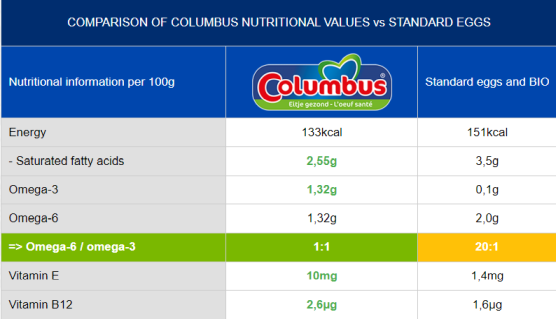
A European RCT (1) that was not industry-sponsored showed that athletes who ate eggs enriched with n-3 PUFAs, selenium, lutein, and vitamin E experienced improved blood vessel function and reduced workout-related stress. Importantly, these eggs helped athletes' bodies respond better to exercise without affecting cholesterol or blood pressure. For BIOS I would recommend sticking to one egg a day as per the recommendations from the AHA, maybe two eggs a day when getting older. It’s from my own experience of consuming these eggs that I can say that they still raise LDL levels and you should account for this when trying to reach the optimal range. If you’re within range with your LDL or need to go higher, go wild on these.
✅ CONSUME ALA-ENRICHED MEAT OR CHICKEN
Grass-fed animals do offer some of the healthy omega-3 fats found in fish but in much smaller amounts. This is because they convert only a portion of the ALA from their diet into the more beneficial EPA and DHA types. While grass-fed meats add valuable ALA to your diet, they aren't a substitute for fatty fish when it comes to getting those crucial preformed omega-3s.
Some companies produce ALA-enriched meat or poultry, which can provide extra omega-3 benefits even if you eat fish regularly. You can also find traditional meats, like certain types of ham, that are naturally higher in healthy fats due to the animal's diet rich in acorns or hazelnuts. However, watch out for high saturated fat or salt content in these products – always choose unprocessed options when possible.
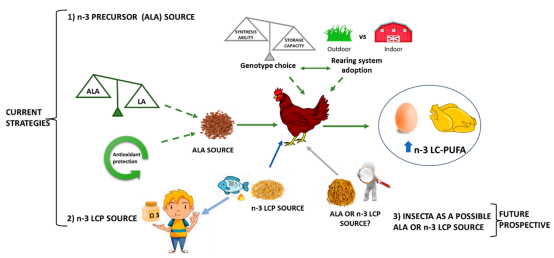
While grass-fed animals primarily provide DPA, a lesser-known omega-3 fatty acid, it plays a surprisingly important role in brain health. Although present in lower amounts than DHA in the brain, DPA serves as a bridge, helping the body convert other omega-3s into more usable forms like EPA and DHA. Additionally, DPA forms its own protective compounds within the brain, supporting healthy immune function, and potentially even improving memory and cognitive processes.
Research suggests DPA may protect against age-related brain inflammation, improve learning, and offer benefits for individuals with depression or those at risk for Alzheimer's disease. DPA plays a role in reducing inflammation, supporting communication between brain cells, and regulating mood. Boosting both DPA and EPA levels might offer unique advantages for overall brain health.
Overall, grass-fed animals are still low on DPA when you compare them to fatty fish. Seal oil is one of the very few natural sources that contain a higher proportion of DPA compared to other omega-3 supplements. (HARP SEAL OIL, Maple Leaf, Canada). And should you get your hands on some whale fat (blubber), it would go a long way.
Grass-fed animals are also rich sources of conjugated linoleic acid (CLA). It exists in multiple forms (isomers), each with potentially different effects on the body. This complexity probably cannot be captured in modern supplements, so those are off the table. Several health benefits are associated with CLA, going from weight loss, and cancer prevention, to enhanced immune function.
✅ Take a seal oil supplement for DPA (optional)
✅ Consume natural or ALA-enriched animal-based foods
✅ Consume flax seeds high in ALA and in a unique type of polyphenol (ligands)
✅ Take a supplement with Perilla oil, a plant that is the highest source of ALA
General
✅Take ω3 preferably in the evening (for better sleep) but also for brain health, because brain maintenance happens at night
Other Omega Fats
✅ Pomegranate seed oil, contains omega-5, a type of conjugated linolenic acid, which means it has a unique chemical structure with multiple double bonds in its fatty acid chain. The main one, punicic acid makes up about 73% of the fatty acids in pomegranate seed oil. Research links this FA to skin health, reducing wrinkles and wounds, and has an overall anti-inflammatory and antioxidant effect.
✅ Sea Buckthorn oil supplement has palmitoleic acid, an omega-7 fatty acid that is less common than omega-3 and omega-6. Benefits for skin, metabolism, mucous membranes, and cardiovascular system, stem cells (activation). Sometimes listed as an adaptogen, grows at high altitudes in the Himalayas, and has over 100 bioactive compounds; tocopherols (all-natural isomers), phenolics, phytosterols, and carotenoids, triterpenoids and proanthocyanidins.
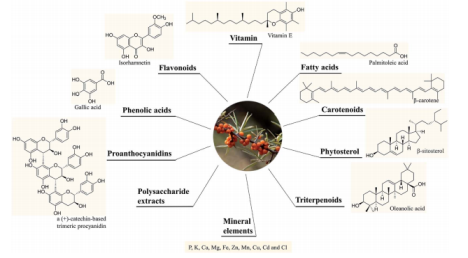
Fish As Medicine And As Natural Anti-Brain Aging “Technology”
In the last few years, dietary recommendations have often advised against fish intake due to high levels of pollutants, and heavy metals like mercury, microplastics, and others. This would supposedly negate the health benefits seen by fish consumption, although most instances still recommend eating fatty fish (rich in ω3), two times a week. And yet, despite all of this pollution, fish keeps getting associated with health improvements, especially for cognition, even in the most recent studies.
Christiano Ronaldo, the almost 40-year-old football star, regularly eats sardines, and his favorite dish with swordfish. It doesn’t seem to hamper his performance. The Adventist 2 study in Loma Linda, should be considered to be highly biased (toward vegetarianism) due to conflicts of interest, and yet, it reports that among their ranks, fish eaters are longer lived than the vegan/vegetarian community members…
We’ve seen that the brain evolved in the ocean, fish and marine foods have all the elements required for brain health. You might as well call them brain medicine, fish intake builts a brain and maintains its integrity across the lifespan, preventing the deterioration normally associated with the aging process.
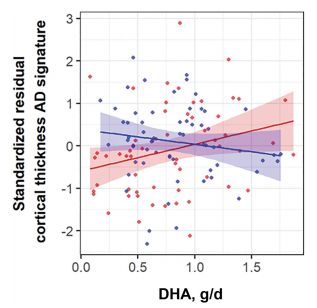
Fish intake directly relates to circulating TMAO levels like no other food does. TMAO is a (wrongfully vilified) substance created by the microbiome after fish consumption. As people age the blood-brain barrier becomes leaky and more easily penetrated by toxins. TMAO makes the blood-brain barrier less leaky. The long-term presence of TMAO in the diet positively influences both blood-brain barrier integrity and cognition – preventing recognition memory impairments – compared to the absence of the molecule (Simon McArthur, et all).
For Michael Crawford, bigger human brains, wouldn’t have happened without fish, they deliver not only the DHA and EPA but a whole host of important brain nutrients such as trace elements iodine, iron, zinc, copper, and selenium, and they all played their part.
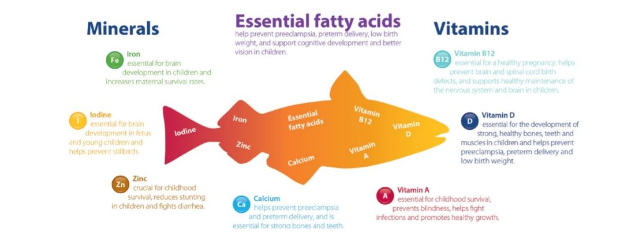
There are the essential fatty acids EPA&DHA which are not found in such quantities in land foods. There is B12 (cobalamine) but also cobalt itself, as being separate from the cobalamin form, scientists speculate that this separate cobalt form is an essential trace mineral for humans and functions as an antioxidant. There is taurine, an amino acid involved in brain function and development and cardiovascular health, the quantities of taurine in marine fish food are easily 10 times higher than in the runner-up, which is meat and poultry. There is carnitine, another antioxidant that plays a role in cognitive function. Fish is one of the few natural sources of iodine, which is important for neurological development and thyroid hormones. Furthermore, it contains the iodide form which might be essential next to iodine.
Regular fish consumption has a positive impact on thyroid homeostasis, facilitates maintenance of healthy body weight, reduces the magnitude of age-associated increases in blood pressure, improves glucose homeostasis, helps prevent diabetes and metabolic syndrome, and has a positive impact on muscle mass preservation among the elderly.
"One of the foods with a large potential for positive impact on hormonal and metabolic homeostasis, and usually recommended as part of a balanced healthy diet in most dietary guidelines is fish". (Mendivil, 2021)
But what about pollutants? First of all, fish is not particularly high in microplastics, certainly when compared to other food sources. As far as the presence of heavy metals is concerned, it has been suggested by some that fish consumption might have been healthy for our ancestors when the seas weren’t polluted yet, but no longer for us modern humans after the industrial revolution. It is important however to acknowledge that our genes have adapted to the human exposome, and fish have always been high in these pollutants due to natural causes such as volcanic activity. Humans should be expected to be able to handle the consumption of fish, and dietary fish content supposedly isn’t that different today than thousands of years ago.
And that is what we can gather from the literature, at recommended dosages of 2 fatty fish meals a week, pregnant women give birth to offspring with better cognitive ability. Even old people with a long history of fish consumption, benefit from better cognitive scores and brain health. Fish consumption and omega-3 polyunsaturated fatty acids from the diet are positively associated with cognitive function in older adults even in the presence of exposure to lead, cadmium, selenium, and methylmercury: a cross-sectional study using NHANES 2011–2014 data (10). Researchers believe that fish contains the molecules needed to detoxify the heavy metals contained in fish, such as selenium.
Marine foods are simply too powerful to not include in a lifelong diet, even if certain metals accumulate a little more in the brain into old age, the benefits outstrip the negatives. Once you get going on a good fish-eating habit, it might be prudent to keep consuming them for life for the same reasons. As far as pregnant women are concerned, sticking to the amounts recommended benefits the child, cognitive function does seem to worsen at higher intake levels though, presumably because the infant is more sensitive and less able to detoxify. Nutrition is always about making compromises, something to keep in mind.
Studies collectively indicate that omega-3 supplementation can have beneficial effects on brain health and cognitive function, potentially reducing the risk of dementia and improving brain structure and performance in various age groups.
Interestingly, we should be thankful because scientists have calculated the dietary needs for optimal omega-3 for the global population, and there are not enough fatty fish around to support the world population.
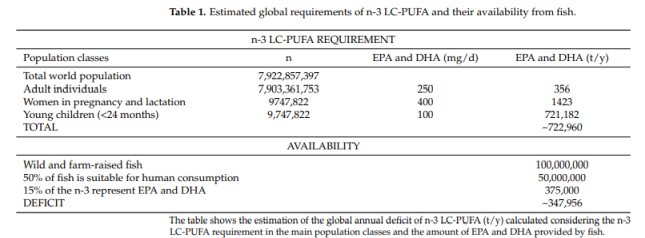
The Pitfalls Of Fish Oil Supplements
Fish oil production is tricky because the valuable omega-3 fatty acids are easily damaged. Traditional processing methods (cooking, pressing, heating) can degrade these delicate fats. Even the standard method for preserving them alters their form from triglycerides to ethyl esters, making them less readily absorbed by the body and more prone to oxidation.
Furthermore, the most brain-healthy form of omega-3s (the phospholipid form) is discarded during the production process. This means standard fish oil often lacks the type of omega-3 fatty acids that directly benefit cognitive function.
The research on fish oil supplements is a mess! Many supplements are already rancid (oxidized) due to the processing methods used, potentially causing more harm than good. A recent industry-sponsored trial called the STRENGTH trial, showed worse cardiovascular health outcomes in people taking high doses of omega-3 supplements. This leads some researchers to suggest avoiding most over-the-counter fish oil products entirely.
The problems go deeper: Fish oil supplements often include an isolated form of vitamin E as an antioxidant. This specific form of vitamin E can actually deplete the other beneficial forms found naturally in the body (6).
High doses of omega-3 polyunsaturated fatty acids (PUFAs) can potentially increase the risk of bleeding and hemorrhagic stroke. Studies have shown that Greenland Inuits, consuming a traditional diet with very high levels of omega-3 PUFAs (around 14 g/day of DHA+EPA), had a higher mortality rate from hemorrhagic stroke compared to those living in Denmark. Conversely, the Nurses’ Health Study found that women with high, but substantially lower than Inuit levels, fish intakes had a reduced risk of ischemic stroke without an increased risk of hemorrhagic stroke. It is noted that very high doses of omega-3 PUFAs, particularly more than 7 grams per day, could lengthen bleeding times and raise the likelihood of hemorrhagic complications.
I would keep this in mind, the next time when you hear a health influencer talk about how they are doing high-level supplements of purified EPA or fish oil. For BIOS, I would keep the 2-gram FDA limit in mind, and limit daily intake to around 1 gram in supplemental form at most while getting the bulk from real foods. Fish oil must be consumed with a meal containing fat from other sources to ensure good absorption. (Therdyothin, A, 2023).
✅On BIOS, limit your fish oil intake. Use real foods.
Krill Oil Supplements
Krill oil may be slightly more effective than fish oil, requiring about 40% less to achieve similar omega-3 levels. However, due to fish oil's higher omega-3 content, larger doses of krill oil are still needed for equivalent omega-3 intake. Recent studies suggest krill oil has somewhat better bioavailability than fish oil due to the presence of phospholipids, but overall not for all subtypes of DHA/EPA, and not as significantly as previously thought or as commercially claimed. Studies have also shown that krill oil fails to raise brain levels of omega 3, to any greater extent than regular fish oil.
Krill oil is often advertised as having better bioavailability, but this has not been confirmed in studies. Both have similar bioavailability, so fish oil usually offers greater value for money where EPA/DHA are concerned. (Therdyothin, A, 2023).
Despite these observations, I still use krill oil in BIOS as a pre-workout.
Aker BioMarine is a type of krill oil that is highly purified to contain less triglycerides and less small salt and TMAO particles with more phospholipids. 1 g of SuperbaBoost™ also results in a choline dose of ~70–80 mg. Krill oil offers a natural source of choline in the beneficial phospholipid form, along with omega-3 fatty acids and antioxidants (astaxanthin). Unfortunately, most of these supplements are rancid.
✅Use SuperbaBoost™ as a pre-workout (two tablets before performance)
CHOLINE
We’ve seen that 90% of Westerners don’t reach the RDI, and athletes need even more choline because exercise depletes choline levels. For the first time, nutrition recommendations are beginning to add choline in recommendations starting in Norway following similar steps taken by dietary authorities in the US and Europe. If regular diets fail to supply ample choline, think about what kind of disaster zone a vegetarian would be if you know that foods that contain much choline are eggs, liver, grass-fed beef, chicken breasts, cod, and shrimp. Broccoli, wheat germ, edamame, and shitake mushrooms have it too.
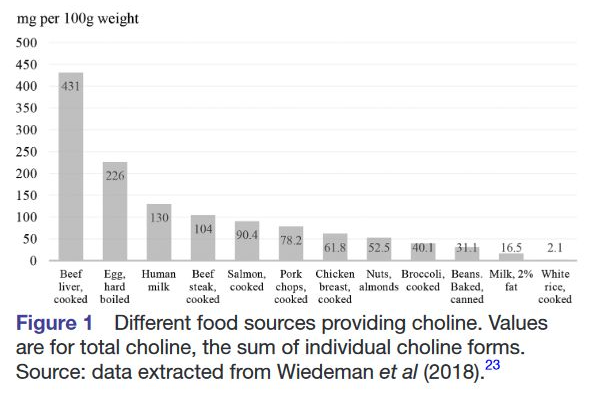
Choline forms phospholipids, the building blocks of cell membranes throughout the body. It's crucial for producing acetylcholine, a neurotransmitter vital for memory, muscle control, and other brain functions. Choline supports healthy metabolism and may help protect against conditions like fatty liver disease, heart disease, and Alzheimer's. Choline may help protect against age-related cognitive decline and reduce the risk of dementia.
While both choline and TMG (trimethylglycine, also known as betaine) can support similar pathways in the body, adding TMG instead of focusing on high-choline foods might not be the best strategy. TMG can be converted into choline in the body, but this process isn't very efficient. Instead of replacing choline-rich foods, athletes might benefit from including TMG alongside those foods. Betaine is an osmolyte helping cell hydration and is a methyl-donor (TMG plays a role in methylation processes, impacting various bodily functions).
✅Include high-choline foods in the diet found in eggs, liver, brains, chicken breasts, grass-fed beef, wheat germ, shitake, edamame, cod, and shrimp.
✅Take a choline supplement (f.e. soy lecithin, optional), soy lecithin provides choline comparable to krill oil (50mg/1g). Lecithin protects brain cell function, take 1-2 tbsps. Other options could be citicoline or alphaGPC (not making recommendations on these).
✅Include betaine sources in your diet, drink beetroot juice, and eat quinoa, and spinach.
✅Take a TMG supplement (optional), which assists the body in utilizing B vitamins, rids the body of toxins, and increases naturally occurring mood elevators. (500-5000mg).
Ensuring adequate choline intake through diet and possibly supplementation is vital for lifelong health, especially during pregnancy, early childhood, and as we age.
The recommended dietary allowance (RDA) for choline varies, with adult men needing about 550 mg/day and adult women needing 425 mg/day, though needs can increase during pregnancy and lactation.
The Purinergic System
ONE BILLY
The purinergic system made up of nucleotides, nucleosides, enzymes, and receptors, plays a key role in brain function and inflammation. While we often associate the nucleotide ATP (adenosine triphosphate) with cellular energy, the purinergic system encompasses a much wider network of signaling molecules and receptors. Nucleotides/nucleosides are also building blocks of DNA and RNA. Cells release nucleotides/nucleosides as signaling molecules into the surrounding environment (extracellular space) and other cell receptors respond to these. These membrane receptors, are among the most abundant receptors in living organisms and appeared early in evolution, more than a billion years ago.

Purinergic signaling is a way for cells to communicate with each other and regulate various body functions, including inflammation, blood clotting, blood vessel dilation, and constriction, but also pain transmission and neurotransmission (communication between enerves). Microglia, the immune cells of the brain, use the purinergic system to communicate and regulate their function in brain development. ATP and adenosine help guide growing neurons to their correct locations within the developing brain. ATP acts as a signaling molecule for the birth of new neurons (neurogenesis) and the formation of connections between them (synaptogenesis). This is crucial during early brain development.
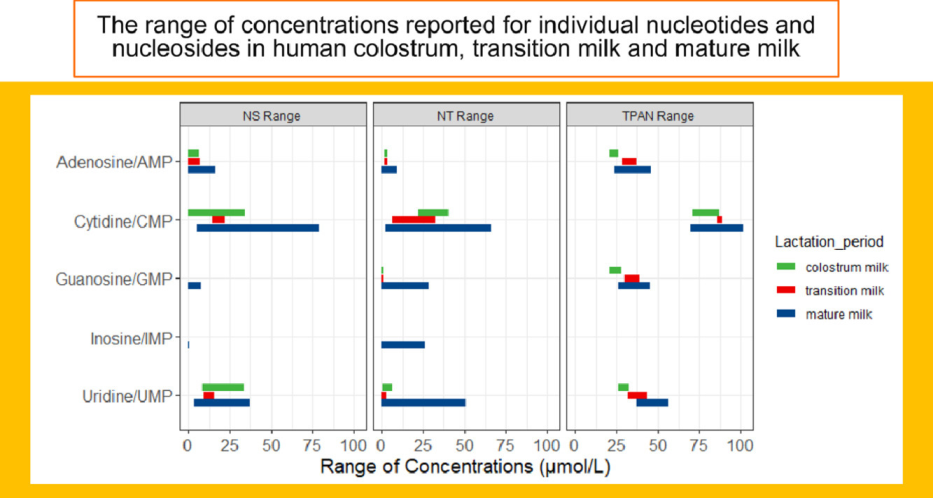
So it’s no surprise that nucleotides are natural components in human breast milk, in amounts higher than in other animals. They play a vital role in the development of the immune and nervous system, as well as the maturation of gut function, and are considered a “special dietary nutrient.” For humans, dietary nucleotides are conditionally essential. The human body can manufacture NTs from scratch using other molecules, but the body also expects the diet to be a source of preformed nucleotides, because, the synthesis in the body is not energy efficient and time-consuming, furthermore. Previously, scientists thought our bodies could produce all the NTs they needed, but recent research shows that external sources of NTs (from food) are crucial for “specific” situations, like fighting infections, starvation, rapid growth (infants), or aging. (Ding, 2021).
The purinergic system is one way how exercise is beneficial to our health, during exercise ATP levels rise, which creates a short-term inflammatory response by purinergic signaling, on the flip side, this signaling becomes an anti-inflammatory factor when ATP enzymatically turns into the nucleoside adenosine, which acts as a protective, anti-inflammatory molecule. This, in turn, could potentially support nucleotide synthesis in the brain. Exercise modulates the purinergic system through all kinds of anti-inflammatory actions. This system, comprised of enzymes, and receptors, is also highly active in the brain where it in the same way helps regulate inflammation, energy metabolism, and cellular communication – all crucial for healthy brain function.
For example, following brain injury or stress, ATP levels often surge as a damage signal. The purinergic system helps to orchestrate the subsequent responses aimed at repair and protection. Purinergic signaling influences the dilation and constriction of blood vessels in the brain, ensuring adequate oxygen and nutrient delivery to active brain regions, it protects against injury and inflammation control.
The true impact of NTs and nucleosides on cellular function and overall health is likely underestimated. The optimal dosage of exogenous NTs for different life stages and health conditions is unknown.
✅ Resistance exercise and exercise in general, can activate purinergic signaling in the brain, lowering neuroinflammation
✅ Nucleotide synthesis is an anabolic process regulated by mTORC1. Cells need energy for this and certain molecular precursors, but also bicarbonate, which normally maintains a stable pH in cells appears to be a building block and limiting factor for nucleotide synthesis. Depleted bicarbonate levels can hamper cell proliferation and nucleotide synthesis. (See BIOS Needs Growth and BIOS Needs Optimal pH).
✅ Folic acid (think beans), is crucial for NT synthesis and is vital for healthy brain development. A lack of folic acid during pregnancy can lead to neural tube defects like spina bifida.
BIOTOSHI’S NUCLEOTIDE REPLACEMENT THEORY
1) For the body
Our genetic information is stored in repeating sequences of nucleotides, abbreviated by the letters A, C, G, and T in DNA, and A, C, G, and U in RNA. DNA is a large molecule that contains millions of nucleotides. Tissues with high turnover rates, like skin, gut lining, blood cells, and those involved in growth/recovery constantly replace damaged and old cells. This requires a lot of DNA and RNA synthesis, and thus, a continuous supply of nucleotides. Athletes push their bodies harder, leading to more cell breakdown and repair. Their nucleotide needs are likely higher than less active individuals.
Dietary nucleotides (NTs) can be obtained through food and supplements. Researchers believe that these preformed nucleotides can be absorbed and utilized by various organs in the body, and even as a probiotic for the microbiome. This external supply of nucleotides may help organs conserve energy and function more optimally. Studies suggest that NTs have numerous health benefits, including antitumor activity, immune system regulation, liver protection, normalization of metabolism, and antioxidant and anti-aging properties.
In early research, NTs have been shown to improve mitochondrial function and inhibit oxidative stress in skeletal muscles, decrease the expression of senescence markers, promote cell viability, augment antioxidant activity, ameliorate SASP and mitochondrial dysfunction, and increase NAD+ production during the HUVECs senescence process. NTs may stimulate various cell types, such as stem cells, liver cells, intestinal cells, and immune cells, to proliferate
A diet high in nucleotides has been shown to prevent capillary regression in rats (small blood vessel loss) superiorly to a diet containing either low or no NLs due to reducing oxidative stress and trough increasing mitochondrial metabolism. (3). Dietary NTs can provide beneficial effects on muscle function, whether during physical exercise or when recovering from an exercise or to counteract the physiological process of muscle mass loss in the elderly.
Recent findings suggest that nucleosides, obtained from our diet and through internal synthesis, can also serve as an alternate energy source for our cells by releasing the ribose sugar molecule which can be used like glucose. In this (4) non-industry-sponsored double-blind, placebo-controlled randomized trial, 14 days of sublingual nucleotides increased performance (time to exhaustion) by 5%. Both ergogenic and immunostimulatory.
2) For the brain
The cerebral cells are not able to synthesize Nucleotides; therefore, the dietary supply is focal for the central nervous system. Nucleotides stimulate the glial cells proliferation, promote cerebral vascular circulation, and improve the lipid metabolism of the cerebral cortex.
Nucleosides, once thought of solely as building blocks for RNA, are emerging as a promising avenue for treating neurological disorders by providing both essential building materials and alternative energy sources for the brain. Many NTs are important neurotransmitters in the human body, and NTs receptors are widely distributed in the brain, which provides a material basis for NTs and their derivatives to play an important biological role. More specifically, the brain cannot perform de novo synthesis of NTs, so a large amount of NT raw materials is needed for salvage synthesis to meet the brain's demand for NTs. Studies show that infants fed formula supplemented with NTs demonstrate a larger head circumference.
In humans, the ongoing generation of new neurons (neurogenesis) is crucial for learning, memory, and healthy cognitive function. This process sadly declines with age, with a sharp decrease in neurogenic potential at the start of middle age. Adult neurogenesis is crucial for cognitive function and memory, so this decline with age is accompanied by cognitive decline.
Studies show a decrease in the WβC (beta-catenin) pathway of Wnt signaling as animals age, which is the basis of this decline. Wnt signaling plays a crucial role in adult neurogenesis, the birth of new neurons. Astrocytes, star-shaped glial cells, can produce Wnt1, which activates the WβC pathway. The astrocytes do this by releasing nucleotides, especially ATP and others. However, during aging, astrocytes reduce nucleotide release due to various accumulating inhibitors and due to rising inflammation. Reduced availability of Wnt signals from astrocytes thus contributes to the decreased production of new neurons in the older brain. ATP and its breakdown products influence cell function by activating different purinergic receptors. Dysfunction in these receptors might also contribute to brain inflammation and cell damage, further worsening age-related cognitive decline.
Wnt/βcatenin signaling has been called “the key to unlocking the mystery of endogenous brain repair”, and could stave off diseases of brain aging such as Parkinson’s (Marchetti, 2019). Studies suggest that activating this pathway could create a more regenerative environment in the brain, promoting the differentiation of new dopamine neurons from existing neural stem cells (NSCs). Activation of a specific purinergic receptor, P2Y4, by nucleotides like ATP or UTP, can lead to increased expression of Wnt3a. (Takei. Y, 2019).
✅ It's likely more beneficial to focus on eating a balanced diet rich in nucleotide sources before considering isolated supplements. As mentioned in Blobspace, pig brains are rich in nucleotides. Overall, respectable levels of NLs are to be found in steak, ham, chicken breasts, and organ meats are a little higher than these still, fish have some too. Plant-based foods are not a good source. (Verkerk, 2012). Although legumes are (Ding, 2021). Dietary NTs can be absorbed and used directly, lessening the need for the body to synthesize them internally.
✅ A natural supplement of NLs could be brewer’s yeast or other yeast-based supplements. Baker yeasts are naturally rich in RNA and yeast extracts are excellent sources of both purine and pyrimidine nucleotides.
✅ Unrefined foods with whole cells have nucleoproteins that get reduced to nucleotides in our small intestine by proteases and to purines by nucleosides. ATP is a nucleotide, it also participates in cell signaling, as cGMP and cAMP, and forms a part of vital cofactors of enzymatic reactions like coenzyme A, NAD, and NADP+.
✅ According to the different nucleotide content in food, daily diet can be divided into high NT and low NT diets. For example, people whose daily diets are mainly seafood, meat, and soy products have significantly higher intake levels of NTs than those whose diets are mainly grains and dairy products (Cunnane & Crawford, 2014). In addition, countries have strict requirements on the level and types of NTs added to infant food, and the main types of additions include AMP, GMP, CMP, UMP, and IMP. In formula milk powder, the level of NTs is about 50 mg/100 g. Adults reap a few grams of NTs a day, as high NT foods typically contain up to 10% of dw as NTs.
✅ Do not take NT supplements when you suffer from gout or when you have cancer.
3) Special focus on supplementing nucleotides Cytidine Monophosphate (CMP), Uridine Monophosphate (UMP) and inosine
As an organ meat, the pig brain is a rich source of various nutrients, including nucleotides like CMP and UMP. They are directly incorporated into RNA strands, which play roles in protein synthesis, gene expression regulation, and various cellular processes.
As components of phospholipids, CMP and UMP are essential for healthy neuronal membranes, influencing signal transmission and overall cellular integrity. CMP and UMP are critical in the formation and repair of axons and myelin sheaths. This promotes efficient nerve signaling and helps protect against damage. They enhance acetylcholine production (a key neurotransmitter for memory and learning) and stimulate the creation of dopamine receptors, offering cognitive benefits. Studies suggest they may aid in the formation of synapses (connections between neurons) and support brain health. Early research indicates the potential for CMP and UMP in protecting and regenerating neurons, with possible applications in neurodegenerative conditions.
By enhancing ATP production, they provide neurons with the fuel they need for maintaining function and responding to demands. Since muscle fatigue is a factor in neurodegenerative diseases, CMP and UMP's ability to reduce fatigue might indirectly promote greater activity. This exercise can be neuroprotective in its own right. They are also able to reduce muscle soreness and fatigue after exercise and could be ergogenic as a pre-workout.
Inosine is another nucleoside, research on its benefits focuses on areas like athletic performance, energy support, and possible neuroprotective effects. Found in some foods, but mostly produced in our bodies during energy metabolism. Inosine breaks down into urate, a potent natural antioxidant within our bodies. Urate neutralizes harmful free radicals in the brain, especially those generated within mitochondria (cells' powerhouses). This reduces cellular damage implicated in neurodegeneration. By protecting mitochondria from oxidative stress, inosine helps ensure optimal energy production and cellular health within neurons. Some studies suggest inosine might help regulate lactate levels in the brain. Elevated lactate can contribute to cell damage, offering another protective avenue.
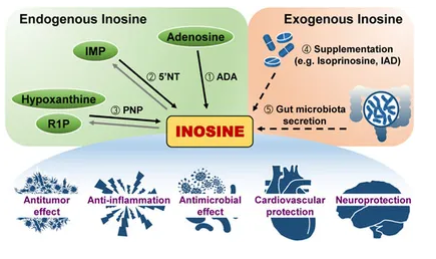
Parkinson's disease and Alzheimer's disease are areas where inosine's protective effects are being explored. While increasing inosine might be beneficial, excessive levels could lead to raised uric acid levels, resulting in stones formation.
✅ (sporadically) Take a brain stack formula that has CMP and UMP or inosine as main ingredients (optional). But remember that blob space and brewer’s yeast already deliver in this regard and might be a safer option. Don’t take these if you suffer from high uric acid levels or gout.
✅ By increasing PC synthesis, which is a key cell membrane component, CMP and UMP indirectly help choline and DHA work even better within the brain. Taking this stack with alpha-GPC for example is particularly efficient at crossing the blood-brain barrier, delivering choline where it's needed most. But here also once again, all of these “biohacks” are covered by blob space consumption, probably in a vastly superior way.
✅ Found in small amounts in foods such as organ meats, certain vegetables, and brewer's yeast.
Conclusion regarding nucleotides.
Nucleotides are emerging as longevity compounds, just like polyamines which they often interlink with. Various nucleotide derivatives from Guanosine Triphosphate, Cytidine Triphosphate, and Inosine Triphosphate are potent cardiomyocyte protectors, highlighting their role in cardiovascular health. (Zobel, 2010).
Short DNA strands (oligonucleotides) surprisingly act as powerful antioxidants, exceeding the potency of Trolox, a standard antioxidant. The primary mechanism seems to be the chelation (binding) of metal ions like iron and copper, preventing them from catalyzing the formation of harmful reactive oxygen species (ROS) from hydrogen peroxide. These molecules are implicated in numerous diseases like Alzheimer's, Parkinson's, cancer, and even the aging process. Many existing antioxidants, including synthetic chelators and some vitamins in high doses, have drawbacks like toxicity, limited effectiveness, or even pro-oxidant effects.
Additionally, oligonucleotides can directly scavenge ROS, adding to their protective effect. Oligonucleotides, even at low micromolar concentrations, effectively protect against oxidative damage by chelating harmful metal ions. Their notable antioxidant properties, potential stability, and biocompatibility make them promising candidates for developing new antioxidant therapies.
AstraZeneca, (the company that developed one of the most widely used but unrelated COVID-19 vaccines), is balls-deep into oligonucleotide therapy research. Seeing that I’m not a pharmacist, (which might benefit BIOS to my more “natural” approach), I’m just going to keep this at suggesting to eat a diet rich in nucleotides, which would provide and break down into all relevant subtypes as a general strategy. Take a nucleotide supplement as a blend or having some of the specific ones we discussed, take it regularly or intermittently. The drawdown of nucleotides is that too much can raise uric acid serum levels (which is not without its benefits), but above levels that are considered to be optimal. So keep an eye on your biostats and adjust.
Milk, Biotoshi’s “Little Blobspace”
No, I’m not going to propose a “Human Breast Milk Quickack”, but I can’t shake the feeling that HBM/milk is the perfect food for brain growth and development. It is filled to the brim with bioactive substances. DHA, ARA, cholesterol, nucleotides; (building blocks for neurotransmitter synthesis), Milk Fat Globule Membrane (MFGM); a complex, triple-layered membrane that surrounds fat droplets in milk. There are growth factors, hormones, there’s human milk oligosaccharides, and immunoglobins that can aid in the gut-brain axis. Studies suggest formula-fed infants may have lower cognitive development compared to breastfed ones, this is because the bioactive lipids are missing in synthetic versions.
For example, milk fat globule membrane (also present in bovine milk), accelerates neurodevelopment when (re)added to baby formulas. MFGM is normally discarded during the homogenization process. Clinical trials show that adding MFGM back to the formula leads to better language scores and motor development scores.
This membrane structure around milk fat lipids is rich in bioactive lipids, this chemical structure potentially helps facilitate efficient absorption and utilization. This fraction is a heterogeneous mixture of phospholipids, sphingolipids, gangliosides, choline, sialic acid, and cholesterol. Replicating this complex lipid profile, as closely as possible, is critical in developing infant formulas to maximize their nutritional benefits and support healthy development. But this might just as well be used by BIOS. And indeed, when looking at the most recent literature, MFGM is proposed as a possible panacea (Raza, 2021) across the lifespan.
In adults, MFGM has improved insulin sensitivity, decreased inflammation markers, and lowered LDL cholesterol levels, with promising findings for cardiometabolic health with improved metabolic parameters (lower cholesterol and triglycerides), and potentially enhanced insulin sensitivity. MFGM as a supplement might improve mobility, muscle mass, and function.
Milk consumption combined with exercise training can promote muscle protein synthesis, leading to better muscle mass and function.
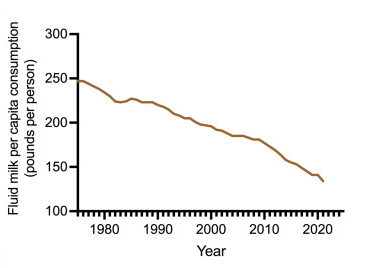
MFGM supplementation (often derived from whey or cream) may help increase the number of active motor units by stimulating the development of neuromuscular junctions. This can lead to improvements in physical function and overall performance. Studies indicate that MFGM combined with exercise can increase ambulatory activities in older adults, positively impacting their ability to move freely and maintain independence. Evidence supports the potential of MFGM supplementation with exercise to increase leg muscle mass, which is crucial for counteracting sarcopenia. Research suggests MFGM supplementation plus exercise can enhance muscle fiber velocity, potentially leading to improved muscle power and movement speed. Even in middle-aged adults, it can improve physical agility through promoting the maintenance of fast-type motor units.
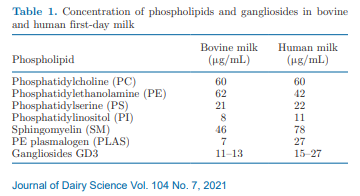
This shouldn’t come as a big surprise, knowing that all the MFGM is doing is delivering the bioactive lipids we have been discussing, inside a highly bioavailable globule. We know that phospholipids are exercise performance enhancers, Pc and PS, and the sphingomyelin in blobspaces like dietary pig brains/milk fat globules develop nerve fibers but also muscle fibers (Yoshinaka, 2018). Bioactive lipids are properly anabolic and ergogenic. MFGM and exercise can promote the expression of docking protein-7 and myogenin mRNA, thereby promoting the formation of neuromuscular junction synapses, (Kim. H, 2015). Previous research points out that the improvement in exercise performance caused by phospholipid supplementation is due to the fact that phospholipids stabilize the cell membrane of red blood cells, thereby improving the oxygen transport capacity of red blood cells (J Pan, 2023).
Studies on rats show increased time to exhaustion when taking MFGM (Haramizu. 2014a). MFGMs have a small, but statistically significant "EPO-effect" and are thus capable of raising both the red blood cell and hemoglobin content - an effect that has been observed in rodents too (Haramizu. 2014b) and may be ascribed to the incorporation of MFGM phospholipids into red blood cells which would in turn be less vulnerable to exercise-related or other stressors.
Research involving both animal and human participants demonstrates the beneficial impact of MFGM-derived sphingomyelin on reducing cholesterol absorption. Milk-derived lipids, especially sphingomyelin, can help inhibit cholesterol absorption in the intestine. Supplementation with whipping cream (high in MFGM) had a positive effect on blood lipid profiles, especially LDL-C ("bad" cholesterol), without increasing overall cholesterol levels (Raza, 2021).
MFGM lipid-enriched formula was associated with a lower frequency of diarrhea in infants compared to a standard formula. This is potentially attributed to phospholipid-induced changes in the gut microbiome or immune system.
44 adults over 65 (healthy or with mild cognitive impairment) were given either MFGM-enriched milk or control milk for 14 weeks and showed promise for improving cognitive function. (Calvo, 2023). In 2024, Lei Deng showed downregulated inflammatory pathways in blood monocytes, thus suggesting a potential inflammation inhibitory effect of milk fat globule membrane. Reduces stress in healthy adults. (Davies, 2023).
MILK QUICK HACKS
✅Milk Fat Globule Membrane (MFGM) supplement, Hari, et al. (2015) show that even 6.5 g/day are without side-effects in healthy humans. 1 gram a day (Soga, 2015) could be an ergogenic dose, for brain health though, lower would also be possible. Studies show that human breast milk tends to have a slightly higher total MFGM concentration compared to bovine milk. However, the differences are not drastic. This is still in much smaller amounts compared to concentrated MFGM supplements. You would need to consume large quantities of milk (600 grams for 1 gram MFGM) and it would preferably have to be raw full-fat milk.
✅Colostrum (the first milk in animals) is naturally rich in nucleotides. These serve as building blocks for DNA and RNA, which are essential for cell growth and repair in a rapidly developing infant. Bovine colostrum is processed into supplements (powders, capsules) to provide a concentrated form of these bioactive components, including nucleotides.
✅ SFAT from dairy is believed to not raise LDL levels, which could be a function of the type of SFAT, or a combination with the presence of bioactive lipids.
✅ Drink low quantities of raw dairy or sheep milk occasionally in your diet, as in the Blue Zones. If you can source it from a verifiably safe producer. If not possible, a high-quality, enriched infant formula might be the next best thing.
✅ Take lactoferrin (LF) supplement, a glycoprotein present in human and bovine milk known for its physiologically pleiotropic effects. Anti-inflammation properties, and antimicrobial and immune-modulating properties. (Berthon, 2022). Moreover, LF has a pivotal role in modulating the major signaling pathways that influence the longevity of organisms. Thus, LF is expected to be able to attenuate the process of aging and greatly ameliorate its effects (Bing, Li, 2022).
✅ As explained in BIOS Needs Fiber, human milk contains special oligosaccharides (HMOs), which produce SCFAs and counter neurodegeneration in the brain, some of them appear to be able to cross the BBB.
✅ Fermented cheese like camembert contains a brain booster known as beta-lactolin. There are antioxidant networks in milk that put its consumption on par with that of healthy plant foods. They hit fat-soluble targets that offer different protection. It can raise endogenous glutathione levels, including in the brain. (non-industrial) Milk is a superfood. Raw cheese could deliver the same effects. Blue Zone Sardinians and Nicoyans receive a whopping 25% of daily calories from dairy.
Cod Liver Oil
Cod liver oil has been used long before the commercial production of fish oil supplements became widespread. Cod liver oil is derived specifically from the liver of codfish and has been used for centuries, particularly in Northern European countries like Norway, Iceland, and other Scandinavian regions. Its use historically stems from its rich content of vitamin D, vitamin A, and omega-3 fatty acids (EPA and DHA).
In Scandinavia and other areas with limited sunlight for significant portions of the year, cod liver oil was traditionally consumed to prevent vitamin D deficiencies. Vitamin D, which is synthesized by the body upon exposure to sunlight, is crucial for maintaining healthy bones and teeth by regulating calcium absorption. In regions where natural sunlight is scarce during long winters, dietary sources of vitamin D become essential to prevent rickets (a disease characterized by weakened bones) and other health issues related to vitamin D deficiency.
The practice of taking cod liver oil for health benefits dates back to the Viking era (around 800-1050 AD) and possibly even earlier. It was not only used as a dietary supplement but also as a remedy for various ailments, including joint pain and rickets. The Industrial Revolution in the 19th century saw cod liver oil being produced and distributed on a larger scale, making it one of the earliest forms of dietary supplements known to man. In contrast, modern fish oil supplements, which can be derived from various species of oily fish (not just cod liver), are a more recent development. These supplements focus more broadly on providing omega-3 fatty acids (EPA and DHA) for cardiovascular health, inflammation reduction, and other benefits, although some may still provide vitamin D.
CLO is a natural source of additional components such as retinol ( aka vitamin A), E, and D, these fat-soluble vitamins can work in tandem. I like preformed vitamin A because if you are of European descent, vitamin A conversion from plants is probably genetically downregulated. Yet, taking CLO every day would deliver too much vitamin A and could lead to hair loss. So I include CLO as a post-workout supplement. To be taken after heavy training or after match days. CLOS has been shown to lower basal and exercise-induced C-reactive protein levels while regular fish oil has not. (18).
✅ Take a small teaspoon of CLO after very intense workouts or matches, don’t overdo it.
Medium-Chain Triglycerides' (MCTs)
Ultimately, fatty acids are generally metabolized in “energy-consuming” organs, such as the liver and muscle, or stored in “energy-keeping” organs like adipose tissue. Medium-chain triglycerides are a type of fat with a shorter chain length compared to typical dietary fats. They are absorbed much faster, are less likely to be stored as body fat, and can easily enter muscle cell mitochondria (energy powerhouses) for quick energy.
While MCTs are saturated, their shorter chain length compared to long-chain triglycerides (LCTs) found in most foods leads to their unique properties and how they're metabolized. For example, MCTs can be used for oxidation by brown fat, while LCTs can’t.
Studies suggest MCTs could improve endurance, especially when combined with carbohydrates, they might help preserve glycogen stores, and crucial energy reserves for intense exercise. MCTs might enhance the body's ability to use fat as fuel. While the effects are modest, a South African study showed that MCTs spare glycogen, and carbohydrates replenish it as it's used, providing sustained energy. So one would see performance benefits when taken together with carbohydrates, MCT spares glycogen while the sugars replenish it. MCT alone would do nothing in regard to performance.
While found in foods like coconut oil, pure MCTs can be purchased as supplements. It might be relevant for endurance athletes competing in events lasting over 3 hours or for athletes performing under high-temperature conditions. Yet, I would like to add this hack to BIOS overall, because it seems to enhance mitochondrial biogenesis, mitochondrial metabolism, mitochondrial functioning (through Akt and AMPK), and downregulates TGF-β signaling (an inhibitor of mitochondrial function).
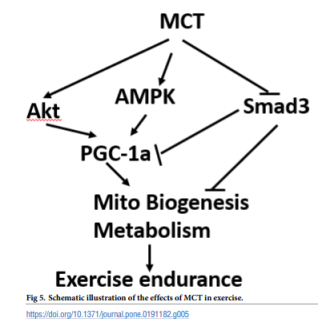
While this was observed in mice originally, there has since been some follow-up with multiple RCTs by the not-so-impartial Nisshin OilliO Group, Ltd., Tokyo, Japan, showing that 2 grams of MCTs can do anything from increased fat-burning in pedestrian-obese individuals, increasing muscle strength from exercise, and increased fat burning after a meal. In any event, I would add these for their role in mitochondrial function, I’ll dig a little deeper and see whether I take them up in “BIOS Needs Growth”.
✅ Take a small amount of MCTs before workouts (In the 2-gram range)
Brown adipose tissue (BAT)
Brown adipose tissue (BAT) and beige fat play important roles in energy metabolism, primarily through the process of nonshivering thermogenesis. This process allows these tissues to burn fatty acids (FAs) and glucose to produce heat, rather than storing them as lipids, which is more characteristic of white adipose tissue (WAT). This capacity for energy dissipation makes BAT and beige fat particularly interesting in the context of obesity and metabolic diseases. We have discussed this at length in “BIOS Needs Cold”. While I would like to make an entire article about this here human superpower, in the context of fatty acids, it is important to know that fatty acid types are both substrates and signaling activators for BAT cell activity and genesis.
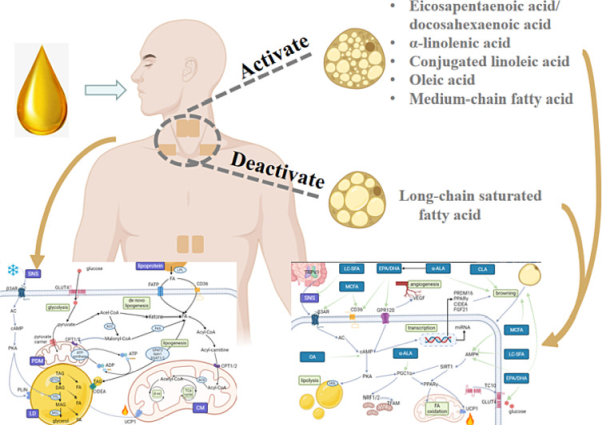
Both BAT and beige fat cells contain numerous mitochondria, which are rich in uncoupling protein 1 (UCP1). UCP1 uncouples oxidative phosphorylation from ATP (adenosine triphosphate) production, allowing the energy derived from the oxidation of substrates to be released as heat rather than stored. This process is crucial for thermogenesis, especially in cold environments.
FAs are not only a primary substrate for thermogenesis but also play a role in signaling pathways that activate and enhance the thermogenic capacity of these fat cells. For instance, the activation of BAT and the browning of WAT into beige fat can be stimulated by certain FAs and their metabolites. For example, EPA and DHA have been extensively studied to activate BAT and beige fat via multiple mechanisms. CLAs (grass-fed meat and dairy) have been reported to reduce the amount of white adipose tissue by inducing lipolysis and browning of WAT, as can most of the bioactive lipids that we have discussed so far.
Reducing dietary SFAT intake remains a goal as it deactivates BAT cell activity. The current diet in the US contains 12% of the total energy as saturated fats, while this value in the Paleolithic diet was only 7.5% (Mancinelli, 2022).
While beige fat might be able to detect cold directly, inducing a thermogenic response even without nerve signals, but the nervous system is a a major regulator of both brown and beige fat. BDNF appears to orchestrate BAT cell biogenesis and activity. BDNF facilitates the growth and development of sympathetic nerves into fat tissue and releases the neurotransmitter norepinephrine from sympathetic nerves, this increases fat cell sensitivity to stimulate thermogenesis and fat burning in brown fat.
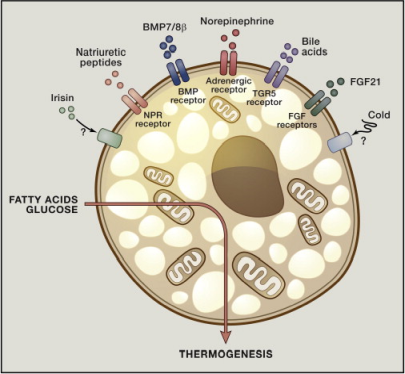
By consuming FAs and glucose for heat production, BAT and beige fat can increase energy expenditure. This capacity is particularly relevant for the prevention and treatment of obesity and its associated metabolic disorders. By enhancing the activity of BAT and the formation of beige fat, it might be possible to shift the balance of energy storage and expenditure in favor of burning excess calories, thereby counteracting weight gain and insulin resistance. Additionally, it would enhance the clearance of serum triglycerides, excess blood glucose, excess BCCAs in the blood, and potentially toxic acylcarnitines.
Glycerol
While glycerol supplementation is used in BIOS in the context of hydration and extracellular-matrix health (both yet unpublished articles of mine), I will note that glycerol can be turned into alkoxy glycerols in the body, which are the precursors to plasmalogens in the peroxisomes.
✅ Stay tuned for my upcoming dosing recommendations in “BIOS Needs Hydration”
Some Random Ramblings
✅ Improvement in brain hemodynamics is seen after the consumption of sulfur-rich garlic from its vasodilation effect. (I will share my garlic hack in BIOS Needs Sulfur, a very powerful pre-workout food). (unpublished)
✅It has been found that polyphenols called flavanoids can pass the blood-brain barrier to function as antioxidants. (See BIOS Needs Polyphenols)(unpublished)
*✅Adaptogens like rhodiola increase certain brain substances such as Neuropeptide Y (NPY) and Heat Shock Protein 72 (Hsp72). *
✅ As with fermented cheeses, the other non-dairy fermented foods, with the interplay of the microbiome, appear to be potent neuroprotectors due to various modulations among the HPA axis (Binna Kim, 2016). Humans and many other species have genetic adaptations to fermented foods. A review of 45 studies shows FF improves memory and slows cognitive decline in animals.
✅ Studies conducted in the past few decades have demonstrated that substances derived from seaweed may be able to pass through the blood–brain barrier and act as neuroprotectants. According to preliminary clinical research, seaweed may also help prevent or lessen the symptoms of cerebrovascular illnesses by reducing mental fatigue, preventing endothelial damage to the vascular wall of brain vessels, and regulating internal pressure. They can control neurotransmitter levels, lessen neuroinflammation, lessen oxidative stress, and prevent the development of amyloid plaques.
✅A 2024 study (Chenyin Wang, 2024) reported that the SCFA propionate strongly suppresses neurodegeneration that accompanies Parkinson's. While supplementing SCFAs directly is generally not a good idea due to uptake in the gut and bioavailability, the best way to naturally raise these levels is explained in detail in “BIOS Needs Fiber”. I have spent very little time explaining the gut-brain axis, everything is connected.
✅ Polyamines such as “Neuridine” aka. N-(3-aminopropyl)butane-1,4-diamine, aka spermidine, is known to protect against amyloid plaques
✅ Klotho protects the brain and keeps levels high by having the optimal blood pH (See BIOS Needs Homeostatic pH)
✅ Taking the supplemental forms at the same time, DHA/EPA and GLA and (natural) vitamin E, prevent oxidation and depletion of DHA/EPA by GLA and vice versa.
✅ Fulvic acid may protect the brain against tau formation (9). (See BIOS Needs Dirt).
✅ Epidemiologists have found that the amounts of lithium found in drinking water correlate with increased life expectancy and reduced brain aging across the globe
✅ Alpha-lipoic acid, A small molecule that easily enters the brain to protect it from free radical damage, it prevents breakdown of all membranes and preserves acetylcholine. Is part of BIOS, for dosing refer to “BIOS Needs Sulfur”. (unpublished)
✅ Boron improves memory function and is part of BIOS, dosing is mentioned in another chapter.
✅ Β-Hydroxy-β-Methylbutyrate (HMB, sports supplement) (optional) is a metabolite of the amino acid leucine, known for promoting muscle growth and aiding recovery, particularly helpful in cases of muscle wasting due to neurodegeneration. Emerging research suggests HMB might directly protect brain cells. Helps maintain mitochondrial health, essential for energy production in neurons. Reduces oxidative stress, minimizing cellular damage implicated in neurodegeneration.
✅ Dietary supplement Palmitoylethanolamide (PEA), is a naturally occurring compound with analgesic (pain-relieving) properties. Modulates inflammatory responses, which can worsen pain and damage neurons. Studies suggest PEA might improve cognitive function, especially in age-related decline and conditions like Alzheimer's Disease. PEA might target inflammation, reduce neurotoxic compounds, and support overall brain health. (Still under review for BIOS, might add dosing when I finish the research).
✅ Ageing is closely linked to changes in hormone levels, particularly sex hormones, which play a significant role in the aging process. Testosterone levels in men have been shown to decline gradually after the age of 40, a pattern confirmed by several longitudinal studies in healthy males. This decline in testosterone affects various bodily functions, given testosterone's role in muscle mass, bone density, and mood regulation. In women, the aging process brings about more pronounced changes in sex hormones, marked by a significant drop in estrogen and progesterone levels during menopause.
Both testosterone and estrogen are synthesized from dehydroepiandrosterone (DHEA) and its sulfated version (DHEA-S), which serve as precursors in the steroid hormone biosynthesis pathway. DHEA and DHEA-S are not only important for the production of sex hormones but also play roles in modulating brain processes and have neuroprotective properties, partly due to their function as antioxidants. There is evidence suggesting that DHEA can promote synaptic plasticity, the ability of synapses (the points of communication between neurons) to strengthen or weaken over time. This plasticity is essential for learning and memory.
Research shows that DHEA-S levels steadily decrease with age in both men and women. However, men generally have higher total levels of DHEA-S compared to women. A significant decrease in DHEA levels with aging has been documented, with adults aged 50–60 showing a 74% and 70% decrease in serum DHEA levels for men and women, respectively. This decline in DHEA and DHEA-S is thought to contribute to the aging process and may impact health and disease susceptibility by influencing hormone production, immune function, and antioxidant capacity.
Supplementing acutely with DHEA as a pre-workout, which is considered to be a “dietary supplement” in the US, has been found to offset the temporary drop in testosterone in men after intense exercise like a soccer match. I am hesitant to add DHEA as a supplement to BIOS, but would allow for this pre-workout approach, and am considering whether to add it as a stand-alone addition during aging. (Ideally, this would belong in “BIOS Needs growth”).
🚫Don’t take L-Theanine, it has been shown to turn fast-twitch muscle fibers into slow-twitch muscle fibers
Epilogue: Biotoshi’s Boosted Blobspace
Unpublished
Epilogue: Biotoshi’s Boosted Blobspace
(1) Kolar, L., Šušnjara, P., Stupin, M., Stupin, A., Jukić, I., Mihaljević, Z., ... & Drenjančević, I. (2023). Enhanced Microvascular Adaptation to Acute Physical Stress and Reduced Oxidative Stress in Male Athletes Who Consumed Chicken Eggs Enriched with n-3 Polyunsaturated Fatty Acids and Antioxidants—Randomized Clinical Trial. Life, 13(11), 2140.
(2) Bozelli Jr, J. C., & Epand, R. M. (2021). Plasmalogen replacement therapy. Membranes, 11(11), 838.
(3) Nakanishi, R., Hashimoto, N., Takuwa, M., Xing, J., Uemura, M., un Nisa, B., ... & Fujino, H. (2023). High Concentrations of Nucleotides Prevent Capillary Regression during Hindlimb Unloading by Inhibiting Oxidative Stress and Enhancing Mitochondrial Metabolism of Soleus Muscles in Rats. Acta Histochemica et Cytochemica, 56(6), 95-104.
(4) Ostojic, S. M., Idrizovic, K., & Stojanovic, M. D. (2013). Sublingual nucleotides prolong run time to exhaustion in young physically active men. Nutrients, 5(11), 4776-4785.